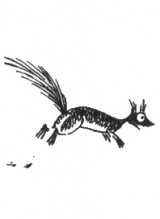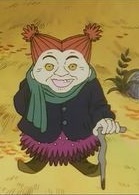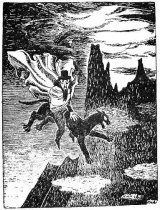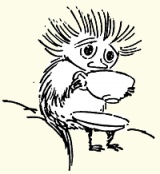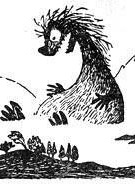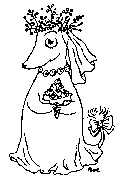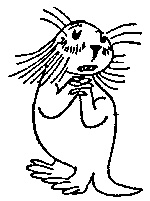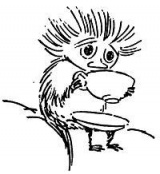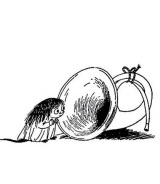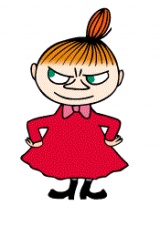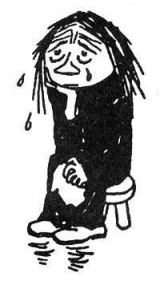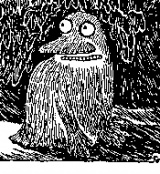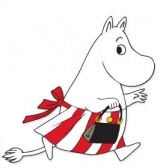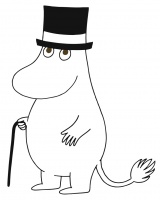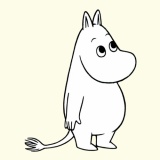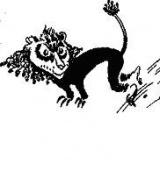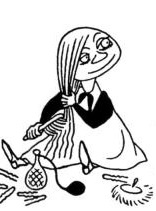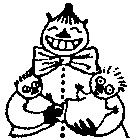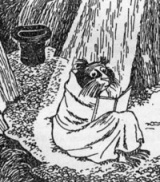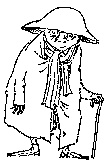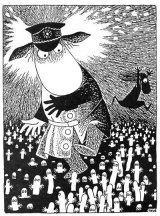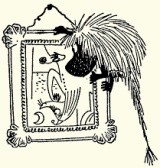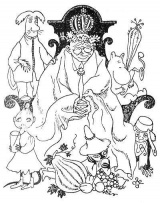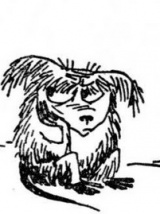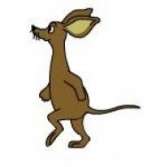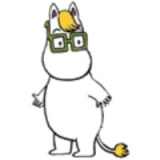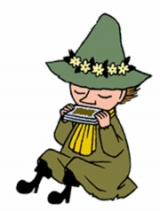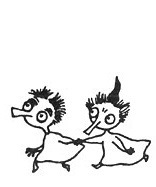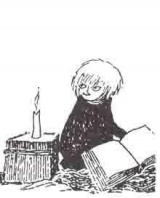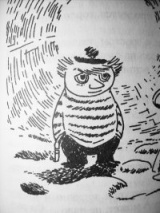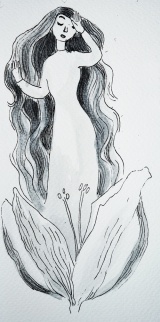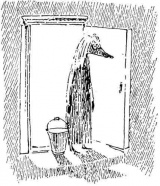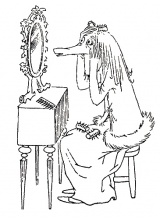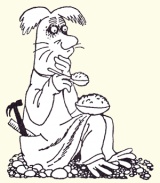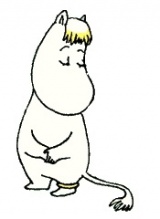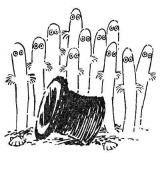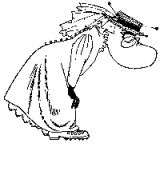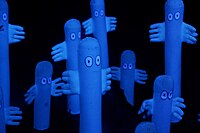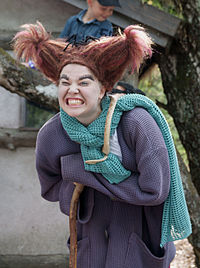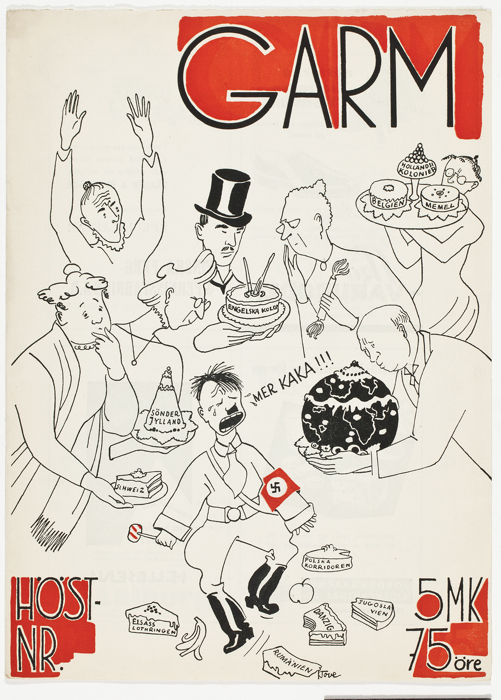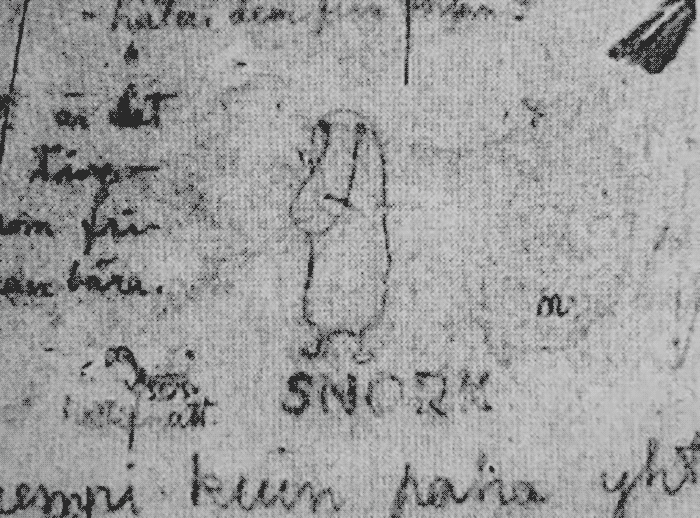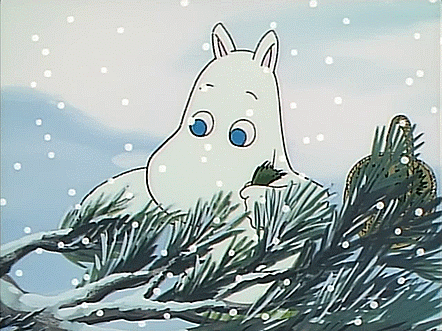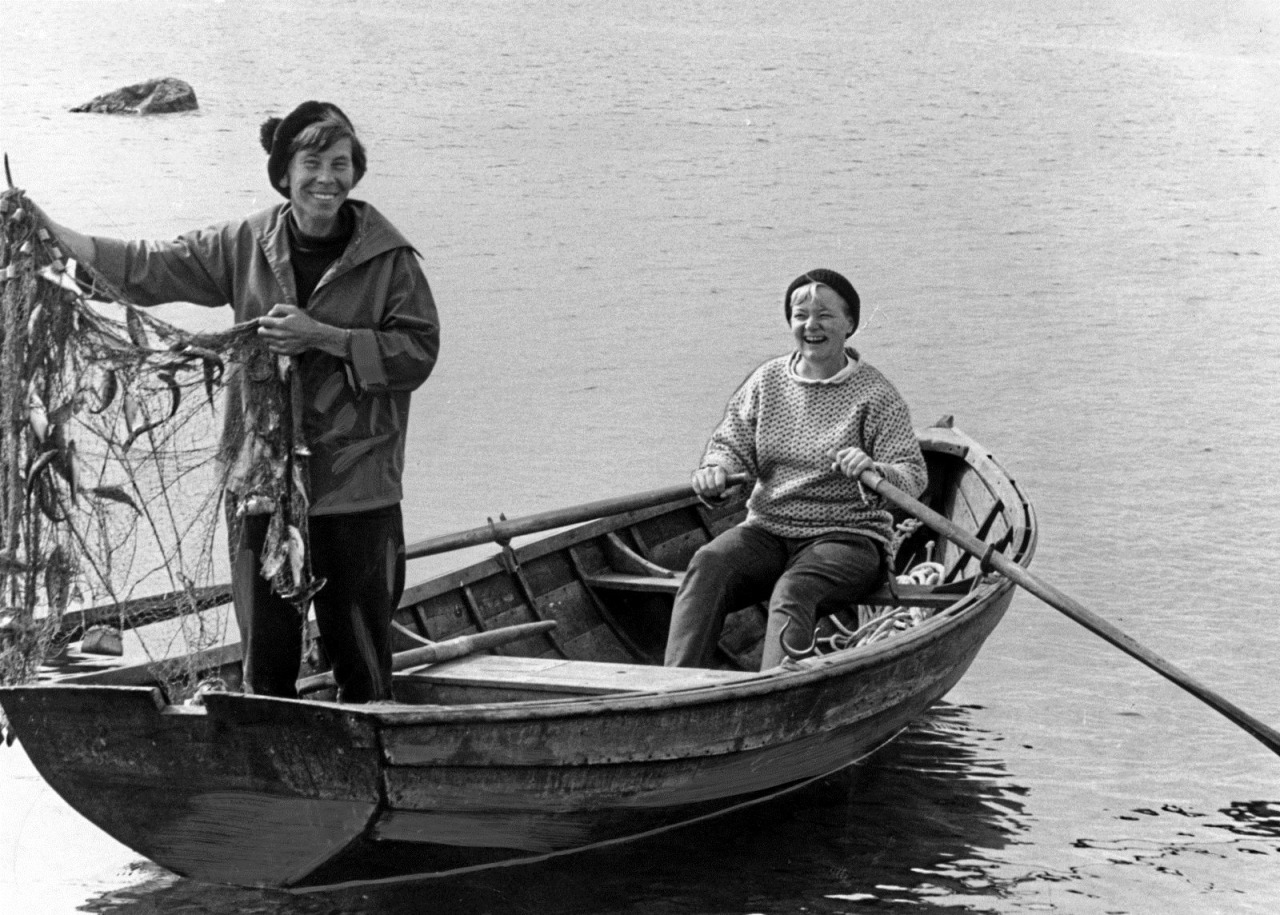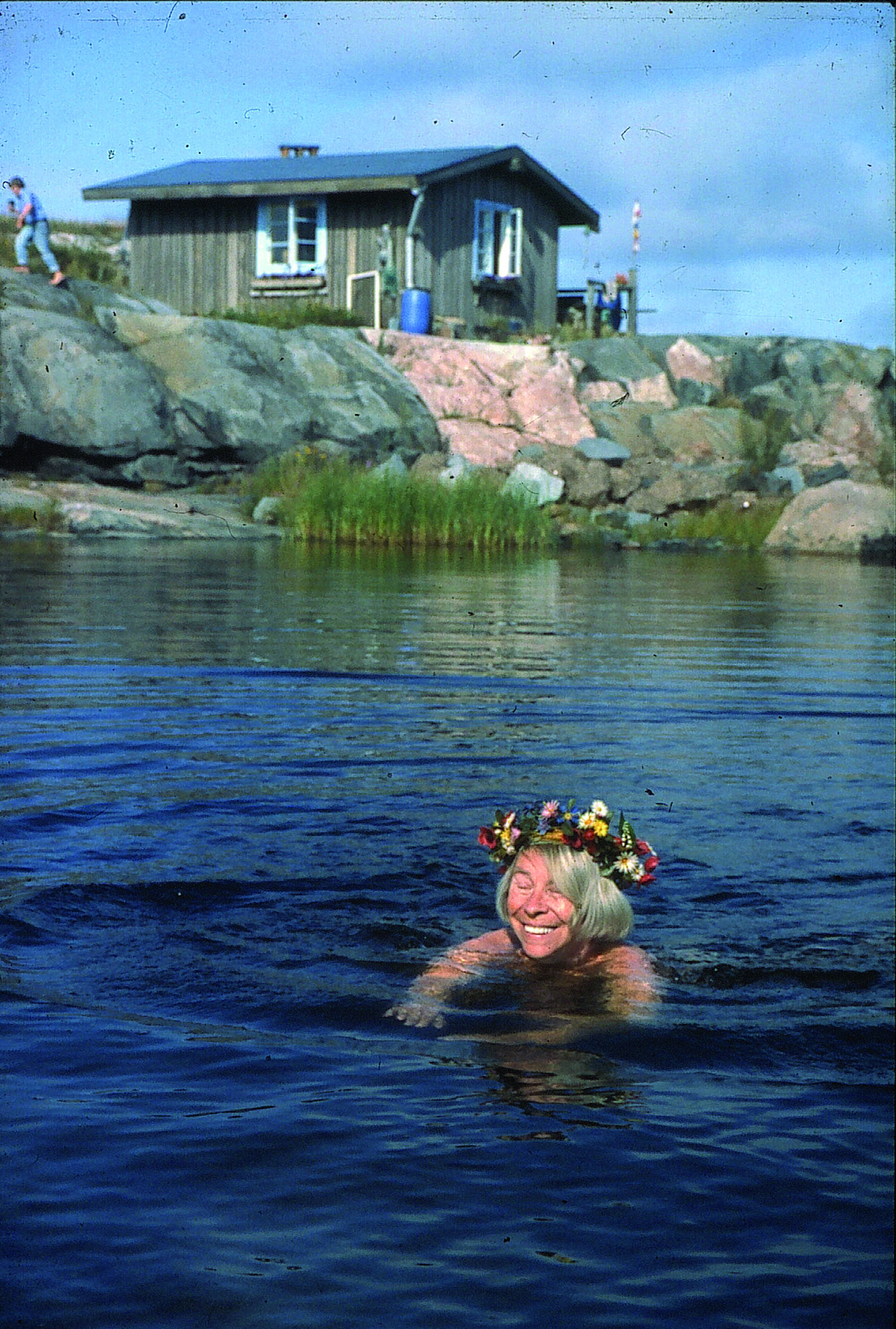Персонажи
- Будем искать среди персонажей фандома
Алисия
1
0
0
Девочка, внучка ведьмы, живёт в лесу. Упоминается только в японских мультфильмах.
Бельчонок с хорошеньким хвостиком
1
0
1
Маленький забывчивый бельчонок, упоминается в книге «Волшебная зима», где замерзает под взглядом Ледяной девы, а весной оживает.
Ведьма
0
0
0
Бабушка Алисии, живёт в лесу. Упоминается только в японских мультфильмах.
Волшебник
0
3
0
Наделён магической силой, но не может исполнять собственные желания. Волшебник появляется в книге «Шляпа волшебника». Его шляпу Муми-тролль, Снусмумрик и Снифф находят в первой главе. Сам Волшебник впервые упоминается в пятой главе и, наконец, появляется в седьмой. Коллекционировал рубины до того как стал обладателем «короля рубинов».
Гафса
0
4
0
Небольшое существо. Впервые появляется в рассказе «Филифьонка, которая верила в катастрофы». Она также присутствует в рассказе «Ёлка» и упоминается в книге «В конце ноября».
Домовой
0
0
0
Родственник Муми-мамы. Упоминается в книге «Муми-тролль и комета».
Дронт Эдвард
0
0
0
Большой дронт, внешне похож на дракона с большими глазами. Незлобный. Дронт Эдвард впервые появляется в книге «Мемуары папы Муми-тролля» во второй главе. Он также присутствует в рассказе «Хемуль, который любил тишину».
Зверюшка Сос
0
0
0
Мать Сниффа, супруга Шнырька. Присутствует в книге «Мемуары папы Муми-тролля», где появляется впервые в восьмой главе.
Клипдасс
0
0
0
Маленький проворный зверёк с острыми зубами, похожий на выдру. Клипдассы живут на дне водоемов, образуя большие колонии. Поверхность их тел очень липкая, благодаря своей клейкости они могут даже взбираться на отвесные стены. Носят бакенбарды. Присутствуют в книге «Мемуары папы Муми-тролля», впервые появляясь в третьей главе.
Кнютт
0
0
0
Крошечное мохнатое существо, тихое и застенчивое.
Крошка Саломея
0
0
0
Малявка с отважным характером, испытывает симпатию к Хемулю-лыжнику. Присутствует в книге «Волшебная зима», впервые появляясь в пятой главе.
Ледяная дева
0
1
1
Воплощение зимы. Персонаж упоминается в книге «Волшебная зима». Везде, где проходит ледяная дева, наступает самая суровая зимняя пора. Под её взглядом любой зверёк замерзает.
Лесной дух
0
0
0
Бестелесное существо, живёт на деревьях в лесу, часто не поодиночке, а колониями.
Малышка Мю
Little My
5
11
2
Сестра Мюмлы и Снусмумрика, дочь Мюмлы-мамы. Самая маленькая мюмла на свете. Внешне похожа на человека, носит платье, волосы убраны в высокий хвост. Характер независимый, ничего не боится, умеет постоять за себя, сообразительна, самостоятельна. Семейство муми-троллей удочерило её. Малышка Мю впервые появляется в седьмой главе книги «Мемуары папы Муми-тролля». Она также присутствует в книгах «Опасное лето», «Волшебная зима» и «Муми-папа и море»; в рассказах «История о последнем на свете драконе», «Дитя-невидимка», «Ёлка». Малышка Мю упоминается, но отсутствует в книге «В конце ноября», в рассказе «Секрет хатифнаттов».
Мальчик с рыжими волосами
0
0
0
Человек. По размерам соизмерим с муми-троллями. Упоминается в книге «Маленькие тролли и большое наводнение».
Мартышка (Котёнок)
0
0
0
Обитатель муми-дола. Мартышка присутствует в книге «Муми-тролль и комета», впервые появляясь в первой главе. В переводе В.Смирновой — Мартышка, в переводе Н.Беляковой — Котёнок.
Миса
0
2
0
Присутствует в книге «Опасное лето», впервые появляясь во второй главе. Она также упоминается в рассказе «Ёлка».
Морра
12
12
4
Пугающее существо, наводящее ужас на большинство персонажей. Одинокая и холодная. Если Морра просидит час на одном месте, земля под ней промёрзнет настолько, что там никогда ничего не вырастет. Стремится к теплу и свету. Морра впервые появляется в шестой главе книги «Шляпа волшебника». Она присутствует также в книгах «Мемуары папы Муми-тролля», «Волшебная зима» и «Муми-папа и море».
Морская лошадь
0
0
0
Живёт в море, танцует в лунном свете. Копыта подкованы серебряными подковами. Морская лошадь очаровывает Муми-тролля в книге «Муми-папа и море».
Муми-мама
Moominmamma
3
12
0
Мама Муми-тролля, супруга Муми-папы. Носит фартук и сумочку, в которой есть всё необходимое. Аккуратная, хозяйственная, гостеприимная. Воплощает образ идеальной мамы и жены. Присутствует в книгах «Маленькие тролли и большое наводнение», «Муми-тролль и комета», «Шляпа Волшебника», «Мемуары папы Муми-тролля», «Опасное лето», «Волшебная зима» и «Муми-папа и море»; в рассказах «История о последнем на свете драконе», «Дитя-невидимка», «Ёлка», «Секрет хатифнаттов» и «Седрик». Муми-мама упоминается, но отсутствует в книге «В конце ноября».
Муми-папа
Moominpappa
1
8
1
Отец Муми-тролля, супруг Муми-мамы, глава семейства. Сирота, воспитывался в приюте вместе с хемулями. До встречи с Муми-мамой много путешествовал. Построил муми-дом и все сооружения самостоятельно. Обладает исследовательскими и писательскими способностями, любит море. Муми-папа впервые упоминается в книге «Маленькие тролли и большое наводнение», а появляется в книге «Муми-тролль и комета». Он также присутствует в таких книгах как «Шляпа Волшебника», «Мемуары папы Муми-тролля», «Опасное лето», «Волшебная зима» и «Муми-папа и море»; в рассказах «История о последнем на свете драконе», «Дитя-невидимка», «Ёлка» и «Секрет хатифнаттов». Муми-папа упоминается, но отсутствует в книге «В конце ноября».
Муми-тролль
Moomintroll
6
17
9
Главный герой истории, сын Муми-мамы и Муми-папы. Внешний вид: похож на бегемотика или гиппопотама белого цвета, с крупным носом, маленькими ушами и глазами, короткими лапами и хвостом. По возрасту — ребёнок, ближе к подростку. Открытый, дружелюбный, любит приключения. Муми-тролль впервые упоминается в книге «Маленькие тролли и большое наводнение» в первой главе. Он также присутствует в книгах «Муми-тролль и комета», «Шляпа Волшебника», «Мемуары папы Муми-тролля», «Опасное лето», «Волшебная зима» и «Муми-папа и море»; в рассказах «История о последнем на свете драконе», «Дитя-невидимка» и «Ёлка». Муми-тролль упоминается, но отсутствует в книге «В конце ноября», а также рассказах «Седрик» и «Весенняя песня».
Муравьиный лев
0
0
0
Злобный персонаж, живёт в песке. Упоминается в книгах «Маленькие тролли и большое наводнение» и «Шляпа Волшебника».
Мюмла
Mymble
2
4
0
Сестра Малышки Мю, сводная сестра Снусмумрика и дочь Мюмлы-мамы. Намного выше Малышки Мю, внешне похожа на человека, ходит в платье, имеет длинные красивые волосы, которые забирает в хвост. Голова большая. Есть маленький хвостик, но его не видно под одеждой. Она впервые появляется в книге «Мемуары папы Муми-тролля», в пятой главе. Присутствует в книгах «Мемуары папы Муми-тролля», «Волшебная зима», «Опасное лето», «В конце ноября» и в рассказе «История о последнем на свете драконе», упоминается в рассказе «Секрет хатифнаттов».
Мюмла-мама
Mymble
0
0
0
Мать Снусмумрика, Малышки Мю, Мюмлы и ещё бесчисленного множества других мюмл. Мюмла присутствует в книге «Мемуары папы Муми-тролля», впервые появляясь в пятой главе.
Нуммулит
0
0
0
Полувымышленный персонаж из научной книги, которую читал хомса Тофт. Доисторический зверёк, который когда-то был очень маленьким, а затем увеличился и стал проявлять агрессию. Пахнет электричеством. Хомса Тофт оживил Нуммулита и отпустил его на свободу. Упоминается в книге «В конце ноября».
Ондатр
2
1
0
Ондатр (он же Выхухоль) — философ. Впервые появляется в первой главе книги «Муми-тролль и комета», также присутствует в книге «Шляпа Волшебника».
Онкельскрут
0
1
0
Родственник муми-троллей. Онкельскрут появляется только в книге «В конце ноября» в первой главе как «старческий голос», разговаривающий со Снусмумриком, присутствует в повествовании с седьмой главы. Стар (около 100 лет). Онкельскрут — не настоящее его имя (настоящее он забыл, выдумал себе новое).
Пожилой Господин
0
0
0
Человек. Упоминается в книге «Маленькие тролли и большое наводнение»
Полицейский Хемуль
0
2
1
Арестовывает Муми-тролля и его друзей в книге «Опасное лето». Впервые появляется в седьмой главе.
Предок
0
1
0
Предок муми-троллей, живёт в печи в муми-доме. Покрыт шерстью. Упоминается в книге «В конце ноября».
Профессор
0
1
0
Профессора работают в обсерватории в Одиноких Горах, изучают звёзды, много курят. Предсказали точное время появления кометы в книге «Муми-троль и комета».
Рыбак (Хранитель маяка)
0
0
0
Рыбак, он же Хранитель маяка, присутствует в книге «Муми-папа и море», где он появляется во второй главе. Небольшого роста, старый, худой. День рождения 3 октября, точный возраст неизвестен.
Самодержец
0
0
0
Человек, владеет островом, любит эффектные зрелища. Упоминается в «Мемуарах Муми-папы» (глава 5).
Скротт
0
0
0
Маленький зверёк с рожками.
Снифф
Sniff
3
3
0
Друг Муми-тролля, сын зверька Шнырька и зверюшки Сос. Внешне похож на крысёнка, маленького роста, с длинным хвостом. Младше Муми-тролля. Живёт в отдельном домике рядом с муми-домом, часто гостит у муми-семьи. Немного труслив и капризен. Снифф с самого начала появляется под именем Маленький Зверёк в книге «Маленькие тролли и большое наводнение». Присутствует в книгах «Муми-тролль и комета», «Шляпа Волшебника», «Мемуары папы Муми-тролля», в рассказе «Седрик».
Снорк
The Snork
1
2
0
Друг муми-семьи, старший брат Фрекен Снорк. Внешне похож на муми-троллей, но меняет окрас в зависимости от настроения. Изобретатель, педант. Впервые упоминается в книге «Муми-тролль и комета» в шестой главе, а появляется сам в седьмой главе. Он присутствует также в книге «Шляпа Волшебника».
Снусмумрик
Snafkin
25
11
2
Лучший друг Муми-Тролля, сын Мюмлы-мамы и Юксаре. Внешне похож на человека, возраст ближе к подростковому. Первая встреча с Муми-Троллем — книга «Муми-тролль и комета». С тех пор лето проводит в Муми-доле, а на зиму отправляется в путешествие на юг. Он также присутствует в книгах «Шляпа Волшебника», «Мемуары папы Муми-тролля», «Опасное лето» и «В конце ноября»; в рассказах «История о последнем на свете драконе» «Весенняя песня», «Седрик» и «Секрет хатифнаттов». Снусмумрик упоминается, но отсутствует в книге «Волшебная зима». Живёт в палатке, играет на губной гармошке, курит трубку, умеет рассказывать интересные истории и сочинять песни. Независимый, любит одиночество. Ненавидит запрещающие объявления и сторожей.
Прототипом этого персонажа является финский журналист и политик Атос Казимир Виртанен, друг Туве Янссон.
Стинки
0
0
0
Появляется только в мультсериале «Муми-тролль». Отрицательный персонаж.
Тофсла и Вифсла
1
1
1
Неразлучная парочка, «иностранцы» (говорят на чужеродном для обитателей муми-дола наречии, добавляя к словам окончание -сла). Маленького роста, пугливые. Присутствуют в книге «Шляпа волшебника», впервые появляясь в шестой главе.
Тофт
1
1
0
Маленький зверёк с развитым воображением, очень любит Муми-маму. До появления в муми-доле жил в лодке Хемуля. Хомса Тофт присутствует в книге «В конце ноября», впервые появляясь в первой главе.
Туу-тикки
3
8
0
Зимой живёт в купальне в муми-доле. Появляется в книге «Волшебная зима» и в рассказе «Дитя-невидимка».
Тюлиппа
0
0
0
Девочка с длинными ярко-голубыми распущенными волосами, человек. Присутствует только в книге «Маленькие тролли и большое наводнение». Прекрасно воспитана. Осталась жить с Рыжим Мальчиком с маяка.
Филифьонка
1
9
2
Филифьонка любит порядок и не любит насекомых. Очень хозяйственная. Не любит родственников. Высокая, худощавая, мордочка вытянутая, похожая на собачью. Впервые появляется в рассказе «Филифьонка, которая верила в катастрофы» а также присутствует в книге «В конце ноября». Также некая филифьонка упоминается в пятой главе «Опасного лета».
Филифьонка (племянница Эммы)
0
3
1
Филифьонка, которая является племянницей театральной крысы Эммы, присутствует в книге «Опасное лето», впервые появляясь в седьмой главе.
Фредриксон
0
0
0
Старый друг Мумии-папы. Присутствует в книге «Мемуары папы Муми-тролля», впервые появляясь в первой главе. Изобретатель, строитель и капитан парохода «Морской Оркестр».
Фрекен Снорк
Snork Maiden
2
4
5
Подруга Муми-тролля, сестра Снорка. Внешне похожа на муми-троллей, но меняет цвет при изменении настроения, покрыта тоненьким мягким пухом и имеет пушистую мягкую чёлку. Носит на ноге золотой бласлет. Хозяйственна, сообразительна, питает симпатии к Муми-троллю. Впервые упоминается в книге «Муми-тролль и комета» в шестой главе, а появляется сама в седьмой главе. Она присутствует также в книгах «Шляпа Волшебника», «Опасное лето», «Волшебная зима»; в рассказах «История о последнем на свете драконе», «Ёлка».
Хатифнатты
2
1
1
Вечные странники, небольшие белые существа без лиц, глаза всегда смотрят вдаль, ничего не говорят и не слышат, не имеют органов дыхания и пищеварения. могут осязать, орган осязания находится у них в животе. Видят плохо. Умеют читать мысли. Питаются электричеством, наэлектризованные светятся и бьются током.. Появляются на свет из семян в день летнего солнцестояния. Путешествуют в маленьких лодочках по всему свету. Раз в год собираются на своем тайном острове. Впервые упоминаются и появляются в книге «Маленькие тролли и большое наводнение» — по словам Муми-мамы именно с ними отправился путешествовать Муми-папа и исчез. Они присутствуют также в книгах «Муми-тролль и комета», «Мемуары папы Муми-тролля», «Шляпа волшебника» и «Опасное лето», а также в рассказе «Секрет хатифнаттов».
Хемулиха-директриса
0
0
0
Директриса приюта, где рос Муми-папа. Присутствует в книге «Мемуары папы Муми-тролля» и впервые появляется в первой главе.
Хемуль
1
3
0
Описание от Муми-папы:
«Хемули достигают почти двойной высоты обычного папоротника. У них вытянутые и немного угнетенные лица. Розовые глаза. Нет ушей, но вместо них несколько пучков синих или цвета имбиря волос. Хемули — вовсе не выдающиеся интеллектуалы и легко становятся фанатиками. Их ноги ужасно большие и плоские. Они не могут научиться свистеть, и поэтому не любят любой свист».
Хемули живут в муми-доле и других местах, упоминаются почти во всех книгах и рассказах.
Some of the many Moomin characters. From left to right, Sniff, Snufkin, Moominpappa, Moominmamma, Moomintroll (Moomin), Mymble, Groke, Snork Maiden and Hattifatteners.
A large number of characters appear in the Moomin series by Tove Jansson. The original Swedish names are given with the etymologies and word associations suggested by Yvonne Bertills in her 2003 dissertation.[1]
Alicia[edit]
(Swedish: Alissa, Finnish: Aliisa) – Alice, the Witch’s granddaughter, likes the Moomins and plays with them on the sly whenever the Witch is otherwise occupied. She is a witch-in-training herself, and develops several magic skills during the series, most notable walking on water, underwater-breathing, and running at lightning speed. Like the Witch, she first appeared in the 1990 animated series and does not appear in the original stories or comic strips.
Anthony[edit]
Anthony is Nanna’s Groom
The Ancestor[edit]
(Swedish: Förfadern, Finnish: Esi-isä) – the Moomintrolls descend from ancient creatures living in tiled stoves. One of those is still dwelling in the Moomin family’s bathing house cupboard and stove. He is called the Ancestor and makes appearances in Moominland Midwinter and Moominvalley in November.
Aunt Hemulen[edit]
Aunt Hemulen appears only in the 1990 edition, in Episode 4 of Season 2.
Aunt Jane[edit]
Billy The Kid[edit]
Billy The Kid appears only in the 1990 edition, in Episode 17 of Season 2. He lives in «Cowboy Country». He is based on the real outlaw with the same name.
Daddy Jones[edit]
(Swedish: Kungen/Självhärskaren, Finnish: Itsevaltias) – the Autocrat in «Exploits». He owns a fairground full of surprises, sits on a throne and gives a blast on his foghorn when he makes royal proclamations.
Dame Elanie[edit]
The Dweller Under the Sink[edit]
(Swedish: den som bor under diskbänken) – a small furry creature that lives under the sink in Moomin House. He only appears in Moominland Midwinter and becomes known to Moomintroll when he wakes up during the long winter hibernation undertaken by the whole Moominfamily. Moomintroll tries to strike up a conversation with him by complimenting on his rather bushy eyebrows, but only succeeds in upsetting him.
Edward the Booble[edit]
(Swedish: dronten Edward – dronten, «dodo», Finnish: drontti Edvard) – a gigantic monster (the second largest creature in the world – only his brother is larger) who pays for people’s funerals if he accidentally treads on them. He is generally bad tempered because of this. He accidentally aids the launch of the Oshun Oxtra (Ocean Orchestra), a boat invented by Moominpappa’s childhood friend, Hodgkins, by sitting in a river bed.
Emma[edit]
(Swedish) – the rather bitter stage rat (teaterråtta). She helps the Moomin family understand what a theater is and also collaborates with Moominpappa on his play, The Lion’s Brides. Before she introduces herself, the family refers to her as Theprop (the prop) after a misunderstanding.
Fillyjonk[edit]
(Swedish: Filifjonkan – no semantic meaning, but with the first element compare filibuffare «joker», filidera, «make bad noise», and with the second, fjompa/fjanta/fjolla + -an = «silly/foolish/fussy woman») – known as The Fillyjonk in some English translations, the first we hear of is the late theatre director in Moominsummer Madness (the Rat is his widow) and the young Fillyjonk who joins the Snork Maiden in the late night jaunt to the wishing well. Later we meet the wonderful psychological study of the «Fillyjonk Who Believed In Disasters» in Tales from Moominvalley. Not a single moment of fantasy or joy, only duties and discipline; she is an extremely methodical person tied down with principles and has a deep rooted belief in prestige and tradition. Nevertheless, after a catastrophe, The Fillyjonk can be freed from the trammels of social expectation and can discover the joys of freedom, irrationality and self-expression. Deep inside she has had a wish to live freely as the Moomin family does, without any worries. Fillyjonks resemble humanoid rodents; they are tall and thin, with long muzzles and raccoon-like rings around their eyes.
Fuzzy[edit]
(Swedish: Sås-djuret – såsa, «to linger; to loiter» + djur, «animal», Finnish: Sosuli) – Sniff’s mother. Married to Muddler.
Gaffsie[edit]
(Swedish: Gafsan – gafsa, «chatter; tittle-tattle», Finnish: Louska) – not much is known about Gaffsie, except that she is a friend of Fillyjonk. She appears most prominently in The Book about Moomin, Mymble and Little My as well as in Tales from Moominvalley in the stories «The Fillyjonk who Believed in Disasters» and «The Fir Tree». She is also mentioned in Moominvalley in November.
Grandpa Grumble[edit]
(Swedish: Onkelskruttet – onkel, «uncle,» also used in the meaning «grandfather»; for the second element, see under Miffle, Finnish: Ruttuvaari) – an old man who appears in Moominvalley in November. He is quite old and somewhat senile. He uses a cane and owns many pairs of glasses that he carries with him in a basket.
The Groke[edit]
(Swedish: Mårran – morra «to growl; to grumble», Finnish: Mörkö – «bogeyman; bugbear») – cold and ghost-like, she represents loneliness and all that is scary in the world of Moomin.
Hattifatteners[edit]
(Swedish: hattifnattar – with the first element compare hatta, «dither»; the second element is related to fnatta (omkring), «flutter around»; få fnatt, «go crazy or get excited over something»; poss. fnatt, «squirrel») – small white ghost-like creatures that resemble worn socks. Hattifatteners are always on the move and travel the sea in large groups (but always in odd numbers), such as boat convoys. They meet every year on a lonely island.[2] Their only goal in life is to reach the horizon. They may communicate using telepathy. The Hattifatteners cannot see very well, but their sense of touch is very strong, and they can feel ground vibrations and electricity. Hattifatteners assemble once a year when they «recharge» in a thunderstorm, when they can cause electrical burns. Hattifatteners grow from seeds, but only if this seed is sown on Midsummer Eve.
Hemulens[edit]
Hemulen in Moomin World theme park, Naantali, Finland.
(Swedish: Hemul – hemul, a legal term, «authority or warrant for something (n.), entitled (adj.)») (In Swedish «Hemulen» means «the hemul») – Hemulens feature frequently in the books. One of them is an avid stamp collector, and another is an avid skier. A female Hemulen raised Moominpappa in an orphanage, and later Moominpappa met her aunt, who looked confusingly like her. Other characters frequently find the Hemulens annoying or overwhelming, as they can be somewhat loud, bossy, abrasive and insensitive, but they are well-intentioned and usually have other redeeming qualities. In the beginning of Finn Family Moomintroll, a hemulen who is a keen stamp collector is depressed, as he has every stamp on the face of earth and has lost his purpose in life. Later on, he finds a new purpose: to collect plants. In Finn Family Moomintroll, «un-Hemulenish» (ohemul) contains a sense of «unwarranted, unjustified».
The Hobgoblin[edit]
(Swedish: Trollkarlen – «The Wizard») – appearing in Finn Family Moomintroll (Swedish: Trollkarlens hatt), he is a powerful magician who travels the Universe with his flying panther, looking for the King’s Ruby. His top hat is found in the Lonely Mountains by Moomintroll, Snufkin and Sniff, who take it back to Moominhouse. Chaos ensues, as anything you put inside the hat is transformed. Moomintroll himself is changed into a strange creature by the hat when he uses it to hide in during a game. The hat also changes the Moominhouse into a sort of jungle. The Hobgoblin has a quite intimidating appearance, but is friendly.
Hodgkins[edit]
(Swedish: Fredriksson – «Frederickson», a common family name) – an inventor and childhood friend of Moominpappa (The Exploits of Moominpappa). He is Muddler’s uncle and thus Sniff’s great-uncle. He builds the Oshun Oxtra (misspelling of Ocean Orchestra in English, known as Haffsårkestern in Swedish), a boat in which Moominpappa and his friends travel on their adventures.
Hodgkins is called Frederickson in some translations, such as the 1990 animated series.
The Island Ghost[edit]
(Swedish: Spöket – «The Ghost») – a spectre that haunts the Island colonised by Moominpappa in «The Exploits of Moominpappa». He is not very good at haunting and gets annoyed when the colonists laugh at him. He takes up knitting to soothe his nerves.
Joxter[edit]
(Swedish: Joxaren, Finnish: Juksu) – The Joxter is Moominpapa’s old friend and father of Snufkin. He is described as worry-free, cat-like and so lazy that he described his perfect life as: “sitting in a fruit tree, eating fruit as it grows”. He appears beige in colour and has water-clear eyes. He has forebodings throughout the book telling his friends of danger. Joxter also shares his son’s dislike of authority figures stating that their family was at war with a park keeper in “The Exploits of Moominpapa”.Joxter is the lover of The Mymble (elder).
The Lady of the Cold[edit]
(Swedish: Isfrun, Finnish: Jäärouva – «The Ice-Lady») – a very creepy, beautiful lady who brings winter to Moominvalley. Looking into her eyes will freeze you, turning you into ice. She is also referred to as «The Great Cold» (Swedish: den Stora Kölden – «The Great Cold», Finnish: Suuri Pakkanen – «The Great Frost») and is the only character that the Groke is genuinely afraid of.
Mermaid[edit]
The green-haired Mermaid appears only in the 1990 edition, in Episode 20 of Season 2.
Miffle[edit]
(Swedish: Skruttet – also as a common noun, det lilla knyttet/skruttet, «the little creep»; skrutt, a noun with «various meanings, although with one common feature, that is something small or something weak, rubbish (skräp, «garbage»), trash or core, which in turn also suggests something quite insignificant and worthless, about to be thrown away. When referring to persons, it is slightly depreciatory, used especially for inferior, sick, incompetent or weak persons (the noun often denotes older persons: skröplig gubbe, «weak old man»). But the noun is also used for small beings with supernatural characteristics, particularly in fairy tales.) – Toffle’s love-object in Who Will Comfort Toffle?
Little My[edit]
(Swedish: Lilla My – my, «micron, mu») is a small, determined and fiercely independent Mymble. When she wants something done, she does it straight away. She is very aggressive and totally disrespectful, but can be a good friend. She is Snufkin’s half-sister.
Misabel[edit]
(Swedish: Misan – misär, «misery»; miserabel, «miserable») – a very depressed and paranoid female character. In comics and picture books, she is usually the Moomin family’s domestic help. Misabel has her only novel appearance in Moominsummer Madness, in which she is not a domestic help, but shows up to be a good actress. She is sometimes the owner of Sorry-oo. It has been said that Misabel’s initial reaction to anyone talking to her is fear of them complaining about the quality of her work.
Moominmamma[edit]
Moominmamma and Moominpappa.
Moominmamma (Swedish: Muminmamman) – the mother of Moomintroll. She is very nurturing and calm.[3] She is almost never without her handbag, which contains essentials like woolly socks, tummy powder, and bark. She makes bark boats every summer, and the first one goes to her favorite.
Moomintroll[edit]
Moomintroll (Swedish: Mumintrollet – invented mumin + troll, «troll»; also simply Moomin) is the protagonist of most of the books.[4]
In the cartoon strip Moomintroll finds himself beset by endless problems. He is a «moomin» – a little white troll with a hippopotamus-like big round snout.[5]
Moomin is very close with Snorkmaiden. They have a very sweet and romantic relationship in the early books.[6] However, later on he and Snorkmaiden are not seen together as often and after ‘Moominland Midwinter’ Moomin refers to Snorkmaiden as a friend. How their relationship is portrayed varies between adaptations. For example, the 1990 animated series shows him consistently, if shyly, returning her affections.
His best friend is Snufkin.[7][8] Snufkin is inspired by Atos Wirtanen, Tove Jansson’s close friend and at one point, fiancé.[9] Moomintroll is also an author avatar for Jansson, meaning the two characters were based on real-life lovers. Because of this real-life parallel, their relationship is sometimes examined in the context of queer theory.[10][11]
Moomintroll was initially called «snork». Jansson described him as her alter ego.[11] The character has a mostly positive reception from critics.[12][13]
The asteroid 58345 Moomintroll was named in his honor.[14]
Moominpappa[edit]
Moominpappa (Swedish: Muminpappan) – orphaned in his younger years, he is a somewhat restless soul who left the orphanage to venture out into the world in his youth, but has now settled down. His eagerness to try new things often sets a story in motion.[3] He usually wears a black top-hat.
Muddler[edit]
(Swedish: Rådd-djuret – rådda «to fuss or muddle or mess about» + djur, «animal») – The nephew of Hodgkins and Sniff’s father. A rather untidy and confused individual who collects buttons of all sorts and lives in the coffee tin where he keeps the buttons. Married to Fuzzy.
The Muskrat[edit]
(Swedish: Bisamråttan) – a philosopher who believes in the pointlessness of things and reads Spengler, appears in Comet in Moominland and Finn Family Moomintroll. The Moomin children annoy him by putting hairbrushes in his bed and such like. He eventually takes to living in the cave Sniff discovers in order to get some peace. There is an unfortunate accident, however: in Finn Family Moomintroll, Moomintroll has hidden the Hobgoblin’s hat there; anything you put in the Hobgoblin’s hat becomes transformed, and the Muskrat gets a nasty shock when he puts his false teeth in it to keep the sand out of them.He enjoys reading a book entitled «the uselessness of everything» which is later changed by the Hobgoblin to «the usefulness of everything».
The Mymbles[edit]
(Swedish: Mymlan – mymla, a slang word used in Tove Jansson’s circle, with the meaning «to love»;[15] compare mumla, «to mumble»;[16]) – «the Mymble» is a description given to two different characters. In The Exploits of Moominpappa, there is a matriarchal character known as «the Mymble». She is the mother of a very large and unspecified number of children, including Little My, Snufkin, and a girl referred to simply as «the Mymble’s Daughter» (Swedish: Mymlans dotter), who appears to be the eldest of the Mymble’s children, and helps her mother with child care for her younger brothers and sisters. In later books and in the comic strips, the Mymble’s Daughter comes to be known as just «the Mymble». She appears again as a relatively minor character in Moominsummer Madness, Moominland Midwinter and the comic strips, and is a significant character in Moominvalley in November and in The Book about Moomin, Mymble and Little My.[17]
Nanna[edit]
Niblings[edit]
(Swedish: klippdassar – «rock hyraxes»; compare dassa, «patter or sneak around, walk quietly; (in some areas) hurry up when working; (in child language and rhymes) dance»; also called by the variant name klibbtassar, explained as klibba/klibbig, «to stick/sticky» + tass, «paw») – small aquatic creatures, which chew off people’s noses if they are too long for their taste. They enjoy doing the multiplication contests devised by the rather bossy Hemulen’s Aunt.
Ninny[edit]
(Swedish – a real female first name, mostly used as a nickname, e.g. for Anna) – Ninny first appears in Tales From Moomin Valley in the story «The Invisible Child». She turned invisible by being frightened too much by her former caretaker. This caretaker gave Ninny to Too-ticky, who then brought her to Moominmama to help make Ninny visible again. Moominmamma succeeds with one of her granny’s ‘Infallible Household Remedies’ and lots of love. Ninny at first is a bore and doesn’t know how to play games or have fun. She becomes completely visible during a day on the beach. Moominpappa plans on sneaking up and scaring Moominmamma, but Ninny rushes up behind and shoves Moominpappa into the sea. In the end, the family realizes Ninny is very similar to Little My.
The Park Keeper[edit]
(Swedish: parkvakten) – a Hemulen in charge of a park where the vegetation is trimmed and cut into proper lines and shapes. The park goes by very strict rules, mostly forbidding things, which are written out in big letters on several signs placed around the park. Of all the people in the world, the Park Keeper is the only one Snufkin really dislikes. Snufkin plants Hattifattener seeds in the grounds of the park to drive the Keeper away and then burns all the signs forbidding things.
The Police Inspector[edit]
(Swedish: Polismästaren) – a by-the-book Hemulen in charge of law enforcement in the valley. He has a crush on Mymble.
The Police Inspector’s Nephew[edit]
Sniff[edit]
(Swedish: Sniff – sniffa, «to snuff/sob; to sniff») – Moomintroll’s immature friend. He is one of the few characters who is interested in money, and is always on the lookout for another way to get rich quick.
Snork[edit]
(Swedish: Snorken) – the Snork Maiden’s older brother, also friends with Moomintroll. He and his sister first meet Moomintroll in Comet in Moominland. After that he appears only in Finn Family Moomintroll. He is described as mauve in colour, though changes to a pale green when frightened. His character is obsessive over details, rules, and protocol in the books. In the Japanese TV series, he is described as an avid inventor who has strong belief in the power of science and an obsession with building a flying vehicle.
Snork Maiden[edit]
(Swedish: Snorkfröken – snorkig, «snooty, snotty»; fröken, «Miss») – Moomintroll’s fair lady friend and admirer. She does fall in love with others sometimes, but returns to Moomintroll before things get too serious. She has blonde hair and sports a golden anklet. She changes color according to her mood, with her baseline color in the books described as pale yellow.[18] Snorks are almost identical to Moomins except that Snorks come in different colors (Moomins are white), have hair on their heads, and their fur changes color depending on their mood. Snorkmaiden is known as Fraulein in the Japanese dub of the 1990s animated series. (Fraulein means «Miss» in German, but is mistakenly Englishized as «Floren» in the English subtitles for the series)
Snufkin[edit]
(Swedish: Snusmumriken – dialectical snusmumrik or mumrik, «old man who talks carelessly; old codger, old bore; old snuff-taker; snotty or scruffy old man,» derived from snus, «snuff,» + interjection mum, also in mumla «mumble,» with pejorative ending -ik) – Moomintroll’s best friend, the son of the elder Mymble and the Joxter, and half-brother to the Mymble’s daughter and Little My. Snufkin wears old green clothes and a wide-brimmed hat that he has had since birth. He lives in a tent, smokes a pipe, and plays the harmonica. He is based on Tove Jansson’s ex-fiancé Atos Wirtanen who was also known to wander.[19]
He lives a nomadic lifestyle, only staying in Moominvalley in the spring and summer, but leaving for warmer climates down south every winter.[20][21]
The character has a mostly positive reception.[22][23][21]
Sorry-oo[edit]
(Swedish: Ynk – ynklig, «poor; miserable»; ynka sig, «moan (v.)»; or ynka, «insignificant») – a small dog appearing in various relations – however, he is always melancholic and longing. He has his only novel appearance in Moominland Midwinter, in which he is constantly howling after his distant cousins the wolves. In The Dangerous Journey, he is called «Sorry-oo Le Miserable» (Ynk von Jämmerlund: jämra sig, «to moan»; jämmer, «moaning,» as in jämmerdal, «vale of tears»; playing on family names in Finland with von, which indicates a foreign name, and -lund).
Stinky[edit]
(Stinky: from English, Finnish: Haisuli) – a criminal by profession, trickster, and a dangerous influence who tempts the Moomin family to do things that are against the law. He has a code of conduct of his own, and is offended when the Moomins want to give him a large sum of money which has been causing them much trouble. Physically, Stinky looks like some sort of furry mammal, whose most characteristic attribute is his constant, unbearable stench. He appears in one book (Villain in the Moominhouse) but mainly in comics and cartoons.
Thingumy and Bob[edit]
(Swedish: Tofslan och Vifslan – tofs, «tuft»; dialectical vivsa, «tuft,» cf. vifta, «wave»; compare the names of Tove Jansson and Vivica Bandler) – two little creatures who turn up in Moominvalley with a large suitcase, which contains the King’s Ruby. They speak a strange language (with «-slan» appended to the ends of some words in the Swedish original, which became spoonerisms, e.g. :»‘Man you cake it out?’ asked Thingumy. ‘Mot nutch,’ said Bob», in the English translation) and are pursued by the Groke who wants the contents. They upset Moominmamma by stealing her handbag. They eventually return it and the whole family throws a party to celebrate. The Hobgoblin arrives when Thingumy and Bob open the suitcase, exposing the King’s Ruby for all to see. They didn’t give him the ruby, but when the Hobgoblin gave everyone there a wish, then they wished for the Hobgoblin to have a ruby as beautiful as theirs; the Queen’s Ruby.
Toffle[edit]
(Swedish: Knytt – as a common noun also translated «creep», e.g. småknytt «little creatures/creeps», etymologically related to «oknytt» which by convention are to knytt what unseelie are to seelie; knytte, «bundle; (fig.) term of endearment for infants, ‘little mite’; (in some dial.) short and/or plump woman»; knytt, dialectical noun from knyst, «the slightest sound») – Toffles are small creatures, shy, scared and confused. A toffle called Salome is featured in Moominland Midwinter and a toffle only named as «Toffle» is the main character in Who Will Comfort Toffle?.
Toft[edit]
(Swedish: (homsan) Toft – for homsan see «Whomper»; Toft is perhaps imaginary, though homonymic with toft, «thwart (n.), rowlock», Finnish: Homssu) – a small, very shy boy who appears in Moominvalley in November. Toft makes up one of the people visiting the Moomins while they are absent. He is very mysterious and seems to have the power to make things he imagines come true. He is also able to use Moominpapa’s crystal ball. In the original book, Toft is a whomper, but the English translator translated his character into a «boy».
Too-Ticky[edit]
(Swedish: Too-ticki) – a friend of the family, craftsman and practical philosopher. Has her first appearance in the novel Moominland Midwinter and returns in the short stories of Tales from Moominvalley and in comics. The character and the name are modelled after Tuulikki Pietilä, Tove Jansson’s life partner.
Whomper[edit]
(Swedish: Homsan – in the plural Whompses in Who Will Comfort Toffle?; homsa or håmsa, «rush, hurry, bustle, or muddle about (v.); do something carelessly (for example work), usually with bad results (v.); untidy or careless female (n.)») – an earnest little chap. He joins the Moomin family on the floating theater in Moominsummer Madness.
The Witch[edit]
The Witch in Moomin World theme park, Naantali, Finland.
(Swedish: Häxan, Finnish: Noita – «The Witch», Japanese: Kurarissa (クラリッサ) – «Clarissa») – The Witch looks quite scary and has some powerful magic in her possession, but is a harmless old lady – despite her strong dislike of the Moomins. She would prefer Alicia not to play with them and pay more attention to her studies, but she does warm up for them later on. The Witch first appeared in the 1990 animated series and does not appear in the original stories or comic strips.
In Episode 77 of Season 1 («The Great Race») of the 1990 edition, Mr. Hemulen refers to the Witch as Clarissa, which is what she is called in the Japanese version.
References[edit]
- ^ Yvonne Bertills, Beyond Identification: Proper Names in Children’s Literature, 2003, dissertation for Åbo Akademi University
- ^ Reuben Sanchez (January 2002), ««We’ve decided to wake a mish for you»: Gift Exchange and Didacticism in Tove Jansson’s Finn Family Moomintroll», The Lion and the Unicorn, 26 (1): 50–65, doi:10.1353/uni.2002.0009, S2CID 144997435
- ^ a b «Moominmamma».
- ^ «The Guardian view on Moomintroll: a hero for our time». The Guardian. 16 December 2016. Retrieved 16 December 2016.
- ^ «Big in Japan, but could America love Moomin?». Reuters. 2009-10-06. Archived from the original on 2014-02-01. Retrieved 2011-10-01.
- ^ «A guide to the Moomin characters». Pan Macmillan. Retrieved 2020-01-11.
- ^ «Moomintroll». Moomin. Retrieved 2020-01-11.
- ^ «Snufkin». Moomin. Retrieved 2020-01-11.
- ^ «Who inspired Tove when creating Snufkin?». Moomin. 2015-08-04. Retrieved 2020-01-11.
- ^ «The secret message in Mymble’s name – queer themes in Tove Jansson’s life and work part 2». Moomin. 2019-06-25. Retrieved 2020-01-11.
- ^ a b Karjalainen, Tuula (2014). Tove Jansson. Work and Love. Penguin UK. ISBN 9781846148491.
- ^ Norrman, Ralf; Haarberg, Jon (1 June 1980). Nature and language: a semiotic study of cucurbits in literature. Routledge & Kegan Paul. ISBN 9780710004536. Retrieved 16 December 2016 – via Internet Archive.
Moomintroll.
- ^ «Books from Finland». Publishers’ Association of Finland. 1 January 1991. Retrieved 16 December 2016 – via Google Books.
- ^ «JPL Small-Body Database Browser». ssd.jpl.nasa.gov. Retrieved 2020-04-08.
- ^ Bertills 2003, p. 126
- ^ Bertills 2003, p. 132
- ^ The Moomin Trove: The Book about Moomin, Mymble and Little My
- ^ «Snorkmaiden». Moomin. Retrieved 2020-01-11.
- ^ Anne Laitinen: Muumit ensimmäisenä lehtenä julkaissut Ny Tid palkittiin (Turun Sanomat 7.11.2006)
- ^ Berthoud, Ella; Elderkin, Susan (5 September 2013). The Novel Cure: An A to Z of Literary Remedies. Canongate Books. ISBN 9780857864260. Retrieved 16 December 2016 – via Google Books.
- ^ a b AbdelRahim, Layla (5 December 2014). Children’s Literature, Domestication, and Social Foundation: Narratives of Civilization and Wilderness. Routledge. ISBN 9781135104603. Retrieved 16 December 2016 – via Google Books.
- ^ Jones, W. Glyn (1 January 1984). Tove Jansson. Twayne Publishers. ISBN 9780805765632. Retrieved 16 December 2016 – via Google Books.
- ^ Lurie, Alison (11 January 2011). Boys And Girls Forever. Random House. ISBN 9781446434475. Retrieved 16 December 2016 – via Google Books.
Some of the many Moomin characters. From left to right, Sniff, Snufkin, Moominpappa, Moominmamma, Moomintroll (Moomin), Mymble, Groke, Snork Maiden and Hattifatteners.
A large number of characters appear in the Moomin series by Tove Jansson. The original Swedish names are given with the etymologies and word associations suggested by Yvonne Bertills in her 2003 dissertation.[1]
Alicia[edit]
(Swedish: Alissa, Finnish: Aliisa) – Alice, the Witch’s granddaughter, likes the Moomins and plays with them on the sly whenever the Witch is otherwise occupied. She is a witch-in-training herself, and develops several magic skills during the series, most notable walking on water, underwater-breathing, and running at lightning speed. Like the Witch, she first appeared in the 1990 animated series and does not appear in the original stories or comic strips.
Anthony[edit]
Anthony is Nanna’s Groom
The Ancestor[edit]
(Swedish: Förfadern, Finnish: Esi-isä) – the Moomintrolls descend from ancient creatures living in tiled stoves. One of those is still dwelling in the Moomin family’s bathing house cupboard and stove. He is called the Ancestor and makes appearances in Moominland Midwinter and Moominvalley in November.
Aunt Hemulen[edit]
Aunt Hemulen appears only in the 1990 edition, in Episode 4 of Season 2.
Aunt Jane[edit]
Billy The Kid[edit]
Billy The Kid appears only in the 1990 edition, in Episode 17 of Season 2. He lives in «Cowboy Country». He is based on the real outlaw with the same name.
Daddy Jones[edit]
(Swedish: Kungen/Självhärskaren, Finnish: Itsevaltias) – the Autocrat in «Exploits». He owns a fairground full of surprises, sits on a throne and gives a blast on his foghorn when he makes royal proclamations.
Dame Elanie[edit]
The Dweller Under the Sink[edit]
(Swedish: den som bor under diskbänken) – a small furry creature that lives under the sink in Moomin House. He only appears in Moominland Midwinter and becomes known to Moomintroll when he wakes up during the long winter hibernation undertaken by the whole Moominfamily. Moomintroll tries to strike up a conversation with him by complimenting on his rather bushy eyebrows, but only succeeds in upsetting him.
Edward the Booble[edit]
(Swedish: dronten Edward – dronten, «dodo», Finnish: drontti Edvard) – a gigantic monster (the second largest creature in the world – only his brother is larger) who pays for people’s funerals if he accidentally treads on them. He is generally bad tempered because of this. He accidentally aids the launch of the Oshun Oxtra (Ocean Orchestra), a boat invented by Moominpappa’s childhood friend, Hodgkins, by sitting in a river bed.
Emma[edit]
(Swedish) – the rather bitter stage rat (teaterråtta). She helps the Moomin family understand what a theater is and also collaborates with Moominpappa on his play, The Lion’s Brides. Before she introduces herself, the family refers to her as Theprop (the prop) after a misunderstanding.
Fillyjonk[edit]
(Swedish: Filifjonkan – no semantic meaning, but with the first element compare filibuffare «joker», filidera, «make bad noise», and with the second, fjompa/fjanta/fjolla + -an = «silly/foolish/fussy woman») – known as The Fillyjonk in some English translations, the first we hear of is the late theatre director in Moominsummer Madness (the Rat is his widow) and the young Fillyjonk who joins the Snork Maiden in the late night jaunt to the wishing well. Later we meet the wonderful psychological study of the «Fillyjonk Who Believed In Disasters» in Tales from Moominvalley. Not a single moment of fantasy or joy, only duties and discipline; she is an extremely methodical person tied down with principles and has a deep rooted belief in prestige and tradition. Nevertheless, after a catastrophe, The Fillyjonk can be freed from the trammels of social expectation and can discover the joys of freedom, irrationality and self-expression. Deep inside she has had a wish to live freely as the Moomin family does, without any worries. Fillyjonks resemble humanoid rodents; they are tall and thin, with long muzzles and raccoon-like rings around their eyes.
Fuzzy[edit]
(Swedish: Sås-djuret – såsa, «to linger; to loiter» + djur, «animal», Finnish: Sosuli) – Sniff’s mother. Married to Muddler.
Gaffsie[edit]
(Swedish: Gafsan – gafsa, «chatter; tittle-tattle», Finnish: Louska) – not much is known about Gaffsie, except that she is a friend of Fillyjonk. She appears most prominently in The Book about Moomin, Mymble and Little My as well as in Tales from Moominvalley in the stories «The Fillyjonk who Believed in Disasters» and «The Fir Tree». She is also mentioned in Moominvalley in November.
Grandpa Grumble[edit]
(Swedish: Onkelskruttet – onkel, «uncle,» also used in the meaning «grandfather»; for the second element, see under Miffle, Finnish: Ruttuvaari) – an old man who appears in Moominvalley in November. He is quite old and somewhat senile. He uses a cane and owns many pairs of glasses that he carries with him in a basket.
The Groke[edit]
(Swedish: Mårran – morra «to growl; to grumble», Finnish: Mörkö – «bogeyman; bugbear») – cold and ghost-like, she represents loneliness and all that is scary in the world of Moomin.
Hattifatteners[edit]
(Swedish: hattifnattar – with the first element compare hatta, «dither»; the second element is related to fnatta (omkring), «flutter around»; få fnatt, «go crazy or get excited over something»; poss. fnatt, «squirrel») – small white ghost-like creatures that resemble worn socks. Hattifatteners are always on the move and travel the sea in large groups (but always in odd numbers), such as boat convoys. They meet every year on a lonely island.[2] Their only goal in life is to reach the horizon. They may communicate using telepathy. The Hattifatteners cannot see very well, but their sense of touch is very strong, and they can feel ground vibrations and electricity. Hattifatteners assemble once a year when they «recharge» in a thunderstorm, when they can cause electrical burns. Hattifatteners grow from seeds, but only if this seed is sown on Midsummer Eve.
Hemulens[edit]
Hemulen in Moomin World theme park, Naantali, Finland.
(Swedish: Hemul – hemul, a legal term, «authority or warrant for something (n.), entitled (adj.)») (In Swedish «Hemulen» means «the hemul») – Hemulens feature frequently in the books. One of them is an avid stamp collector, and another is an avid skier. A female Hemulen raised Moominpappa in an orphanage, and later Moominpappa met her aunt, who looked confusingly like her. Other characters frequently find the Hemulens annoying or overwhelming, as they can be somewhat loud, bossy, abrasive and insensitive, but they are well-intentioned and usually have other redeeming qualities. In the beginning of Finn Family Moomintroll, a hemulen who is a keen stamp collector is depressed, as he has every stamp on the face of earth and has lost his purpose in life. Later on, he finds a new purpose: to collect plants. In Finn Family Moomintroll, «un-Hemulenish» (ohemul) contains a sense of «unwarranted, unjustified».
The Hobgoblin[edit]
(Swedish: Trollkarlen – «The Wizard») – appearing in Finn Family Moomintroll (Swedish: Trollkarlens hatt), he is a powerful magician who travels the Universe with his flying panther, looking for the King’s Ruby. His top hat is found in the Lonely Mountains by Moomintroll, Snufkin and Sniff, who take it back to Moominhouse. Chaos ensues, as anything you put inside the hat is transformed. Moomintroll himself is changed into a strange creature by the hat when he uses it to hide in during a game. The hat also changes the Moominhouse into a sort of jungle. The Hobgoblin has a quite intimidating appearance, but is friendly.
Hodgkins[edit]
(Swedish: Fredriksson – «Frederickson», a common family name) – an inventor and childhood friend of Moominpappa (The Exploits of Moominpappa). He is Muddler’s uncle and thus Sniff’s great-uncle. He builds the Oshun Oxtra (misspelling of Ocean Orchestra in English, known as Haffsårkestern in Swedish), a boat in which Moominpappa and his friends travel on their adventures.
Hodgkins is called Frederickson in some translations, such as the 1990 animated series.
The Island Ghost[edit]
(Swedish: Spöket – «The Ghost») – a spectre that haunts the Island colonised by Moominpappa in «The Exploits of Moominpappa». He is not very good at haunting and gets annoyed when the colonists laugh at him. He takes up knitting to soothe his nerves.
Joxter[edit]
(Swedish: Joxaren, Finnish: Juksu) – The Joxter is Moominpapa’s old friend and father of Snufkin. He is described as worry-free, cat-like and so lazy that he described his perfect life as: “sitting in a fruit tree, eating fruit as it grows”. He appears beige in colour and has water-clear eyes. He has forebodings throughout the book telling his friends of danger. Joxter also shares his son’s dislike of authority figures stating that their family was at war with a park keeper in “The Exploits of Moominpapa”.Joxter is the lover of The Mymble (elder).
The Lady of the Cold[edit]
(Swedish: Isfrun, Finnish: Jäärouva – «The Ice-Lady») – a very creepy, beautiful lady who brings winter to Moominvalley. Looking into her eyes will freeze you, turning you into ice. She is also referred to as «The Great Cold» (Swedish: den Stora Kölden – «The Great Cold», Finnish: Suuri Pakkanen – «The Great Frost») and is the only character that the Groke is genuinely afraid of.
Mermaid[edit]
The green-haired Mermaid appears only in the 1990 edition, in Episode 20 of Season 2.
Miffle[edit]
(Swedish: Skruttet – also as a common noun, det lilla knyttet/skruttet, «the little creep»; skrutt, a noun with «various meanings, although with one common feature, that is something small or something weak, rubbish (skräp, «garbage»), trash or core, which in turn also suggests something quite insignificant and worthless, about to be thrown away. When referring to persons, it is slightly depreciatory, used especially for inferior, sick, incompetent or weak persons (the noun often denotes older persons: skröplig gubbe, «weak old man»). But the noun is also used for small beings with supernatural characteristics, particularly in fairy tales.) – Toffle’s love-object in Who Will Comfort Toffle?
Little My[edit]
(Swedish: Lilla My – my, «micron, mu») is a small, determined and fiercely independent Mymble. When she wants something done, she does it straight away. She is very aggressive and totally disrespectful, but can be a good friend. She is Snufkin’s half-sister.
Misabel[edit]
(Swedish: Misan – misär, «misery»; miserabel, «miserable») – a very depressed and paranoid female character. In comics and picture books, she is usually the Moomin family’s domestic help. Misabel has her only novel appearance in Moominsummer Madness, in which she is not a domestic help, but shows up to be a good actress. She is sometimes the owner of Sorry-oo. It has been said that Misabel’s initial reaction to anyone talking to her is fear of them complaining about the quality of her work.
Moominmamma[edit]
Moominmamma and Moominpappa.
Moominmamma (Swedish: Muminmamman) – the mother of Moomintroll. She is very nurturing and calm.[3] She is almost never without her handbag, which contains essentials like woolly socks, tummy powder, and bark. She makes bark boats every summer, and the first one goes to her favorite.
Moomintroll[edit]
Moomintroll (Swedish: Mumintrollet – invented mumin + troll, «troll»; also simply Moomin) is the protagonist of most of the books.[4]
In the cartoon strip Moomintroll finds himself beset by endless problems. He is a «moomin» – a little white troll with a hippopotamus-like big round snout.[5]
Moomin is very close with Snorkmaiden. They have a very sweet and romantic relationship in the early books.[6] However, later on he and Snorkmaiden are not seen together as often and after ‘Moominland Midwinter’ Moomin refers to Snorkmaiden as a friend. How their relationship is portrayed varies between adaptations. For example, the 1990 animated series shows him consistently, if shyly, returning her affections.
His best friend is Snufkin.[7][8] Snufkin is inspired by Atos Wirtanen, Tove Jansson’s close friend and at one point, fiancé.[9] Moomintroll is also an author avatar for Jansson, meaning the two characters were based on real-life lovers. Because of this real-life parallel, their relationship is sometimes examined in the context of queer theory.[10][11]
Moomintroll was initially called «snork». Jansson described him as her alter ego.[11] The character has a mostly positive reception from critics.[12][13]
The asteroid 58345 Moomintroll was named in his honor.[14]
Moominpappa[edit]
Moominpappa (Swedish: Muminpappan) – orphaned in his younger years, he is a somewhat restless soul who left the orphanage to venture out into the world in his youth, but has now settled down. His eagerness to try new things often sets a story in motion.[3] He usually wears a black top-hat.
Muddler[edit]
(Swedish: Rådd-djuret – rådda «to fuss or muddle or mess about» + djur, «animal») – The nephew of Hodgkins and Sniff’s father. A rather untidy and confused individual who collects buttons of all sorts and lives in the coffee tin where he keeps the buttons. Married to Fuzzy.
The Muskrat[edit]
(Swedish: Bisamråttan) – a philosopher who believes in the pointlessness of things and reads Spengler, appears in Comet in Moominland and Finn Family Moomintroll. The Moomin children annoy him by putting hairbrushes in his bed and such like. He eventually takes to living in the cave Sniff discovers in order to get some peace. There is an unfortunate accident, however: in Finn Family Moomintroll, Moomintroll has hidden the Hobgoblin’s hat there; anything you put in the Hobgoblin’s hat becomes transformed, and the Muskrat gets a nasty shock when he puts his false teeth in it to keep the sand out of them.He enjoys reading a book entitled «the uselessness of everything» which is later changed by the Hobgoblin to «the usefulness of everything».
The Mymbles[edit]
(Swedish: Mymlan – mymla, a slang word used in Tove Jansson’s circle, with the meaning «to love»;[15] compare mumla, «to mumble»;[16]) – «the Mymble» is a description given to two different characters. In The Exploits of Moominpappa, there is a matriarchal character known as «the Mymble». She is the mother of a very large and unspecified number of children, including Little My, Snufkin, and a girl referred to simply as «the Mymble’s Daughter» (Swedish: Mymlans dotter), who appears to be the eldest of the Mymble’s children, and helps her mother with child care for her younger brothers and sisters. In later books and in the comic strips, the Mymble’s Daughter comes to be known as just «the Mymble». She appears again as a relatively minor character in Moominsummer Madness, Moominland Midwinter and the comic strips, and is a significant character in Moominvalley in November and in The Book about Moomin, Mymble and Little My.[17]
Nanna[edit]
Niblings[edit]
(Swedish: klippdassar – «rock hyraxes»; compare dassa, «patter or sneak around, walk quietly; (in some areas) hurry up when working; (in child language and rhymes) dance»; also called by the variant name klibbtassar, explained as klibba/klibbig, «to stick/sticky» + tass, «paw») – small aquatic creatures, which chew off people’s noses if they are too long for their taste. They enjoy doing the multiplication contests devised by the rather bossy Hemulen’s Aunt.
Ninny[edit]
(Swedish – a real female first name, mostly used as a nickname, e.g. for Anna) – Ninny first appears in Tales From Moomin Valley in the story «The Invisible Child». She turned invisible by being frightened too much by her former caretaker. This caretaker gave Ninny to Too-ticky, who then brought her to Moominmama to help make Ninny visible again. Moominmamma succeeds with one of her granny’s ‘Infallible Household Remedies’ and lots of love. Ninny at first is a bore and doesn’t know how to play games or have fun. She becomes completely visible during a day on the beach. Moominpappa plans on sneaking up and scaring Moominmamma, but Ninny rushes up behind and shoves Moominpappa into the sea. In the end, the family realizes Ninny is very similar to Little My.
The Park Keeper[edit]
(Swedish: parkvakten) – a Hemulen in charge of a park where the vegetation is trimmed and cut into proper lines and shapes. The park goes by very strict rules, mostly forbidding things, which are written out in big letters on several signs placed around the park. Of all the people in the world, the Park Keeper is the only one Snufkin really dislikes. Snufkin plants Hattifattener seeds in the grounds of the park to drive the Keeper away and then burns all the signs forbidding things.
The Police Inspector[edit]
(Swedish: Polismästaren) – a by-the-book Hemulen in charge of law enforcement in the valley. He has a crush on Mymble.
The Police Inspector’s Nephew[edit]
Sniff[edit]
(Swedish: Sniff – sniffa, «to snuff/sob; to sniff») – Moomintroll’s immature friend. He is one of the few characters who is interested in money, and is always on the lookout for another way to get rich quick.
Snork[edit]
(Swedish: Snorken) – the Snork Maiden’s older brother, also friends with Moomintroll. He and his sister first meet Moomintroll in Comet in Moominland. After that he appears only in Finn Family Moomintroll. He is described as mauve in colour, though changes to a pale green when frightened. His character is obsessive over details, rules, and protocol in the books. In the Japanese TV series, he is described as an avid inventor who has strong belief in the power of science and an obsession with building a flying vehicle.
Snork Maiden[edit]
(Swedish: Snorkfröken – snorkig, «snooty, snotty»; fröken, «Miss») – Moomintroll’s fair lady friend and admirer. She does fall in love with others sometimes, but returns to Moomintroll before things get too serious. She has blonde hair and sports a golden anklet. She changes color according to her mood, with her baseline color in the books described as pale yellow.[18] Snorks are almost identical to Moomins except that Snorks come in different colors (Moomins are white), have hair on their heads, and their fur changes color depending on their mood. Snorkmaiden is known as Fraulein in the Japanese dub of the 1990s animated series. (Fraulein means «Miss» in German, but is mistakenly Englishized as «Floren» in the English subtitles for the series)
Snufkin[edit]
(Swedish: Snusmumriken – dialectical snusmumrik or mumrik, «old man who talks carelessly; old codger, old bore; old snuff-taker; snotty or scruffy old man,» derived from snus, «snuff,» + interjection mum, also in mumla «mumble,» with pejorative ending -ik) – Moomintroll’s best friend, the son of the elder Mymble and the Joxter, and half-brother to the Mymble’s daughter and Little My. Snufkin wears old green clothes and a wide-brimmed hat that he has had since birth. He lives in a tent, smokes a pipe, and plays the harmonica. He is based on Tove Jansson’s ex-fiancé Atos Wirtanen who was also known to wander.[19]
He lives a nomadic lifestyle, only staying in Moominvalley in the spring and summer, but leaving for warmer climates down south every winter.[20][21]
The character has a mostly positive reception.[22][23][21]
Sorry-oo[edit]
(Swedish: Ynk – ynklig, «poor; miserable»; ynka sig, «moan (v.)»; or ynka, «insignificant») – a small dog appearing in various relations – however, he is always melancholic and longing. He has his only novel appearance in Moominland Midwinter, in which he is constantly howling after his distant cousins the wolves. In The Dangerous Journey, he is called «Sorry-oo Le Miserable» (Ynk von Jämmerlund: jämra sig, «to moan»; jämmer, «moaning,» as in jämmerdal, «vale of tears»; playing on family names in Finland with von, which indicates a foreign name, and -lund).
Stinky[edit]
(Stinky: from English, Finnish: Haisuli) – a criminal by profession, trickster, and a dangerous influence who tempts the Moomin family to do things that are against the law. He has a code of conduct of his own, and is offended when the Moomins want to give him a large sum of money which has been causing them much trouble. Physically, Stinky looks like some sort of furry mammal, whose most characteristic attribute is his constant, unbearable stench. He appears in one book (Villain in the Moominhouse) but mainly in comics and cartoons.
Thingumy and Bob[edit]
(Swedish: Tofslan och Vifslan – tofs, «tuft»; dialectical vivsa, «tuft,» cf. vifta, «wave»; compare the names of Tove Jansson and Vivica Bandler) – two little creatures who turn up in Moominvalley with a large suitcase, which contains the King’s Ruby. They speak a strange language (with «-slan» appended to the ends of some words in the Swedish original, which became spoonerisms, e.g. :»‘Man you cake it out?’ asked Thingumy. ‘Mot nutch,’ said Bob», in the English translation) and are pursued by the Groke who wants the contents. They upset Moominmamma by stealing her handbag. They eventually return it and the whole family throws a party to celebrate. The Hobgoblin arrives when Thingumy and Bob open the suitcase, exposing the King’s Ruby for all to see. They didn’t give him the ruby, but when the Hobgoblin gave everyone there a wish, then they wished for the Hobgoblin to have a ruby as beautiful as theirs; the Queen’s Ruby.
Toffle[edit]
(Swedish: Knytt – as a common noun also translated «creep», e.g. småknytt «little creatures/creeps», etymologically related to «oknytt» which by convention are to knytt what unseelie are to seelie; knytte, «bundle; (fig.) term of endearment for infants, ‘little mite’; (in some dial.) short and/or plump woman»; knytt, dialectical noun from knyst, «the slightest sound») – Toffles are small creatures, shy, scared and confused. A toffle called Salome is featured in Moominland Midwinter and a toffle only named as «Toffle» is the main character in Who Will Comfort Toffle?.
Toft[edit]
(Swedish: (homsan) Toft – for homsan see «Whomper»; Toft is perhaps imaginary, though homonymic with toft, «thwart (n.), rowlock», Finnish: Homssu) – a small, very shy boy who appears in Moominvalley in November. Toft makes up one of the people visiting the Moomins while they are absent. He is very mysterious and seems to have the power to make things he imagines come true. He is also able to use Moominpapa’s crystal ball. In the original book, Toft is a whomper, but the English translator translated his character into a «boy».
Too-Ticky[edit]
(Swedish: Too-ticki) – a friend of the family, craftsman and practical philosopher. Has her first appearance in the novel Moominland Midwinter and returns in the short stories of Tales from Moominvalley and in comics. The character and the name are modelled after Tuulikki Pietilä, Tove Jansson’s life partner.
Whomper[edit]
(Swedish: Homsan – in the plural Whompses in Who Will Comfort Toffle?; homsa or håmsa, «rush, hurry, bustle, or muddle about (v.); do something carelessly (for example work), usually with bad results (v.); untidy or careless female (n.)») – an earnest little chap. He joins the Moomin family on the floating theater in Moominsummer Madness.
The Witch[edit]
The Witch in Moomin World theme park, Naantali, Finland.
(Swedish: Häxan, Finnish: Noita – «The Witch», Japanese: Kurarissa (クラリッサ) – «Clarissa») – The Witch looks quite scary and has some powerful magic in her possession, but is a harmless old lady – despite her strong dislike of the Moomins. She would prefer Alicia not to play with them and pay more attention to her studies, but she does warm up for them later on. The Witch first appeared in the 1990 animated series and does not appear in the original stories or comic strips.
In Episode 77 of Season 1 («The Great Race») of the 1990 edition, Mr. Hemulen refers to the Witch as Clarissa, which is what she is called in the Japanese version.
References[edit]
- ^ Yvonne Bertills, Beyond Identification: Proper Names in Children’s Literature, 2003, dissertation for Åbo Akademi University
- ^ Reuben Sanchez (January 2002), ««We’ve decided to wake a mish for you»: Gift Exchange and Didacticism in Tove Jansson’s Finn Family Moomintroll», The Lion and the Unicorn, 26 (1): 50–65, doi:10.1353/uni.2002.0009, S2CID 144997435
- ^ a b «Moominmamma».
- ^ «The Guardian view on Moomintroll: a hero for our time». The Guardian. 16 December 2016. Retrieved 16 December 2016.
- ^ «Big in Japan, but could America love Moomin?». Reuters. 2009-10-06. Archived from the original on 2014-02-01. Retrieved 2011-10-01.
- ^ «A guide to the Moomin characters». Pan Macmillan. Retrieved 2020-01-11.
- ^ «Moomintroll». Moomin. Retrieved 2020-01-11.
- ^ «Snufkin». Moomin. Retrieved 2020-01-11.
- ^ «Who inspired Tove when creating Snufkin?». Moomin. 2015-08-04. Retrieved 2020-01-11.
- ^ «The secret message in Mymble’s name – queer themes in Tove Jansson’s life and work part 2». Moomin. 2019-06-25. Retrieved 2020-01-11.
- ^ a b Karjalainen, Tuula (2014). Tove Jansson. Work and Love. Penguin UK. ISBN 9781846148491.
- ^ Norrman, Ralf; Haarberg, Jon (1 June 1980). Nature and language: a semiotic study of cucurbits in literature. Routledge & Kegan Paul. ISBN 9780710004536. Retrieved 16 December 2016 – via Internet Archive.
Moomintroll.
- ^ «Books from Finland». Publishers’ Association of Finland. 1 January 1991. Retrieved 16 December 2016 – via Google Books.
- ^ «JPL Small-Body Database Browser». ssd.jpl.nasa.gov. Retrieved 2020-04-08.
- ^ Bertills 2003, p. 126
- ^ Bertills 2003, p. 132
- ^ The Moomin Trove: The Book about Moomin, Mymble and Little My
- ^ «Snorkmaiden». Moomin. Retrieved 2020-01-11.
- ^ Anne Laitinen: Muumit ensimmäisenä lehtenä julkaissut Ny Tid palkittiin (Turun Sanomat 7.11.2006)
- ^ Berthoud, Ella; Elderkin, Susan (5 September 2013). The Novel Cure: An A to Z of Literary Remedies. Canongate Books. ISBN 9780857864260. Retrieved 16 December 2016 – via Google Books.
- ^ a b AbdelRahim, Layla (5 December 2014). Children’s Literature, Domestication, and Social Foundation: Narratives of Civilization and Wilderness. Routledge. ISBN 9781135104603. Retrieved 16 December 2016 – via Google Books.
- ^ Jones, W. Glyn (1 January 1984). Tove Jansson. Twayne Publishers. ISBN 9780805765632. Retrieved 16 December 2016 – via Google Books.
- ^ Lurie, Alison (11 January 2011). Boys And Girls Forever. Random House. ISBN 9781446434475. Retrieved 16 December 2016 – via Google Books.
Муми-тролль (швед. Mumintrollet) — главный герой книг о муми-троллях.
Живёт в Муми-доме вместе со своими родителями — Муми-папой и Муми-мамой. Он лучший друг Снусмумрика, и также хорошо дружит со многими другими существами, населяющими Муми-дол, такими как Снорочка и Снифф; Муми-тролль часто идёт на приключения с ними.
Описание с официального сайта[]
| “ | Вы уже встречались с Муми-троллем?
Он приятный парень, который интересуется всем, что видит. Мир полон захватывающих вещей, чтобы исследовать, но Муми-тролль особенно любит собирать камни и раковины. Он также любит море, как и вся семья муми-троллей. Многие посетители заглядывают в Муми-дом, и Муми-тролль всегда счастлив, когда он проводит время со своими друзьями. Он очень верит в своих друзей и беспокоится, если кто-то из них несчастлив. Муми-тролль и сам очень чувствителен, но никогда не держит зла. Муми-тролль считает, что Муми-дол — самое безопасное и интересное место в мире. Вот почему он такой любопытный и смелый – он может исполнить своё желание понимать странные вещи и странных существ без необходимости их бояться. Единственное, что заставляет Муми-тролля чувствовать себя плохо, это то, что его оставили одного. Муми-тролль — мечтатель и мыслитель, а путешественник-одиночка Снусмумрик — его лучший друг. Каждый ноябрь, когда Снусмумрик уходит на зиму на юг, он оставляет Муми-троллю специальное письмо. В нем он обещает вернуться в Муми-дол в первый день весны. Муми-тролль любит Муми-маму и свою семью больше всего на свете. Нет такой проблемы, которую Муми-мама не могла бы решить. И когда Муми-папа придумывает хороший предлог для приключения, Муми-тролль всегда готов следовать за ним. Когда Снорочка становится его подругой, Муми-тролль узнает, что любовь иногда может заставить чувствовать себя задумчивым и даже совершенно грустным. Мы встречаем Муми-тролля сразу же в первой книге о муми-троллях — «Маленькие тролли и большое наводнение». Муми-тролль не достигает совершеннолетия во время муми-историй, но он действительно растёт в книге «Зима Муми-тролля». Муми-тролля легко узнать по его нежному, круглому виду и пучку на конце хвоста. У всех муми-троллей большие глаза и маленькие уши.
|
” |
Внешний вид[]
Муми-тролль похож на большинство других муми-троллей с белым мехом и большим круглым носом, что делает его похожим на гиппопотама. Он единственный член семьи муми-троллей, у которого нет никаких особых аксессуаров или предметов одежды, связанных с ним.
Личность[]
Муми-тролль очень добрый и благонамеренный, однако он довольно эмоционален и склонен к грусти или беспокойству. Он имеет острый дух приключений и часто следует туда, куда друзья берут его.
В комиксах он обычно более несчастен или раздражен, чем в книгах. В первых книгах он зависел от других, например, от Муми-мамы и Снусмумрика. Это было особенно верно в первой книге, где Муми-мама должна была принимать все решения и заботиться о нем и Сниффе. Однако позже он становится более независимым и взрослым, особенно в «Зиме Муми-тролля», где ему приходится выживать в новых условиях суровой зимы без своей семьи.
Отношения[]
- Снусмумрик
Снусмумрик — лучший друг Муми-тролля, которого он обожает за свой беззаботный образ жизни. Муми-тролль — единственный, из-за кого Снусмумрик всегда возвращается весной, чтобы провести год в Муми-доле до следующей зимы.
- Снифф
Снифф также хороший друг Муми-тролля и его семьи, который проживает вместе с ними в Муми-доме.
- Снорочка
Снорочка — подруга Муми-тролля. Было много намёков, что Муми-тролль является романтическим интересом Снорочки, хотя их отношения очень невинны.
- Туу-тикки
Туу-тикки также подруга Муми-тролля.
История[]
Муми-тролль появляется во всех книгах о муми-троллях (кроме «В глубине ноября») и во всех других муми-медиа.
Приключения муми-троллей[]
Муми-тролль является одним из главных героев в аниме-сериале «Приключения муми-троллей» длящегося с 1990 по 1992. Он живет в Муми-доме со своими родителями. Муми-тролль является одним из немногих персонажей, которые появляются в каждом эпизоде шоу.
Интересные факты[]
- Туве Янссон впервые нарисовала Муми-тролля ещё будучи ребёнком.
- В честь Муми-тролля назван астероид 58345.
В апреле в издательстве Zangavar выйдет долгожданная пятая книга комиксов о Муми-троллях — это последний том, созданный Туве Янссон в сотрудничестве с братом Ларсом (затем издательство возьмется за продолжения приключений, которые написаны Ларсом уже без участия сестры). В преддверии этого знаменательного события «Горький» подготовил гид по вселенной муми-троллей.
Алиса в стране чудес 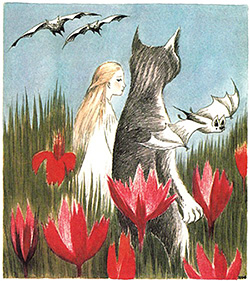
Аллюзии Интертекст «Муми-троллей» — прекрасная тема для диссертации: отсылки к историческим событиям, произведениям мировой культуры и к мифам народов мира разбросаны по книгам и комиксам Янссон. В «Шляпе волшебника» впервые появляются намеки на существование человеческой культуры в мире муми-троллей. Фрекен Снорк, увенчанная венком из цветов, обнаруживает прекрасную «деревянную даму», которая, как она сначала решила, утонула. Ее изображение — привет знаменитой Офелии Милле. Причем Муми-мама тут же улавливает сущность деревянной Офелии и восклицает: «О, прекрасная дама! Подумать только, быть такой красивой и не испытывать от этого никакой радости!» Еще один типичный пример — реплика из разговора маленького папы Муми-тролля с Хемулихой: «А может, тот муми-тролль, который мне приснился, и есть настоящий, а тот, который находится здесь, просто приснился вам, тетенька», — отсылает к диалогу Алисы с Труляля и Траляля, когда близнецы убеждают Алису, что она всего лишь снится Черному Королю (а сам диалог обыгрывает сон мотылька из Чжуан-Цзы). В той же «Шляпе волшебника» — самой откровенно пародирующей приключенческие романы книге о муми-троллях, Муми-тролль и фрекен Снорк играют в Тарзана и Джейн в джунглях, хотя ничего ни разу не говорится о наличии людей или человеческой цивилизации в муми-вселенной. Более того, Муми-тролль в образе Тарзана начинает говорить по-английски: «Tarzan hungry, Tarzan eat now!» И фрекен Снорк объясняет это тем, что «как только попадаешь в джунгли, сразу начинаешь говорить по-английски».
Богема Семья Муми-троллей, возможно, самая богемная в детской литературе: они курят, пьют и ругаются, а еще они любят путешествовать и хорошо проводить время. Мумрики и мюмлы к тому же заводят детей без брака. С уровнем гедонизма муми-троллей может сравниться только уровень их толерантности к самым разным существам и их гостеприимство, ведь дом муми-троллей — это постоянно расширяющееся пространство мирного сосуществования между такими противоположными сущностями, как снорки и филифьонки. Богемность муми-тролли унаследовали от семьи Янссон, где веселые пирушки и постоянные гости, остававшиеся в доме сколь угодно долго, были нормой. Самой Туве Янссон в какой-то момент даже не хотели продлевать контракт на аренду художественной студии из-за постоянных громких вечеринок. Слишком буржуазный образ жизни муми-троллей не радовал и финскую общественность в 1970-е годы.
Вода Море, реки и потопы, тающий снег — неотъемлемая часть мира муми-троллей. Вода опасна и необходима, она основа жизни. Самое страшное следствие приближения кометы к Муми-дален — глобальная засуха. Море — это и возможность передвижения, и залог приключений. Именно море приносит Муми-папе прекрасную Муми-маму.
Война Туве Янссон мало значения придавала внутренней политике, но была активной пацифисткой. Вслед за матерью она пришла работать в шведско-финский антифашистский журнал Garm, и ее карикатура на Гитлера, ревущего младенца, которому европейские лидеры несут на блюдечках все новые территории, в свое время была очень популярной. Первая книга о муми-троллях «Маленькие тролли и большое наводнение» появилась потому, что Янссон переживала тяжелейший кризис во время финско-советской войны и надвигавшейся Второй мировой и не могла заниматься своим главным делом — живописью. Ей хотелось уйти от безысходности реальности, и она начала придумывать сказочные истории. «Комета прилетает» — вышедшая в 1946 году вторая книга цикла — рефлексия Янссон об атомной бомбе как апокалипсисе. Комета как символ разрушений — прямая отсылка к бомбардировке Хиросимы и Нагасаки. Другая примета уже послевоенного мира — дом подкидышей муми-троллей, который держит Хемулиха, аналогия с пополнившимися огромным числом детей разных национальностей детдомами Европы, мотив, который постоянно присутствует в послевоенной европейской литературе.
Времена года Мир муми-троллей постепенно из сказочного становится мифологическим, и не последнюю роль в этом играет цикличность повествования: весна, лето, осень и зима — ось времени муми-троллей, для которых течение лет мало что меняет. Поэтому приключения героев — это по сути классический аграрный миф. Но времена года носят и символический характер для самой Туве Янссон. Зима — время спячки — олицетворяет оцепенение чувств и усталость, упадок творческих сил. Именно поэтому переход от приключенческих к философским сказкам происходит в «Волшебной зиме», когда Туу-тикки открывает Муми-троллю чудеса снежного времени года, о которых он раньше и не догадывался. Лето же — символ полноты жизни и счастья, это всегда «безопасное лето детства», которое в своих сказках воссоздала Янссон. Недаром самая светлая «взрослая» вещь Янссон называется «Летняя книга». Самая грустная книга о муми-троллях, написанная после смерти ее матери, — «В конце ноября».
Выхухоль Философ, предрекающий конец света и проповедующий тщетность всего сущего. Выхухоль — своеобразная противоположность Снусмумрика, потому что он презирает мелочные переживания других людей и сравнивает их с истинными философскими проблемами, при этом сам он не благостен и не умеет ценить жизнь такой, как она есть. Выхухолью герой стал в переводе Брауде и Беляковой, хотя классический перевод «Ондатр» точнее: по-шведски он зовется Bisamråttan, то есть bisam — ондатра плюс Råttor — крыса.
Генезис Происхождение каждого героя «Муми-троллей» невероятно важно для них самих и значимо в контексте мифа о муми-троллях. Все хотят знать хоть что-то о своих родственниках, а Муми-тролль в «Волшебной зиме» обнаруживает своего предка, просто тролля, и ему хватает мудрости понять, что они действительно похожи. Крыса Эмма, тетя Филифьонки, уверена, что племянница не испытывает к ней родственных чувств, а каждый год зовет ее праздновать день летнего солнцестояния лишь потому, что хочет пробиться в театр. Неумение ценить семейные узы, как и заведомая уверенность в дурных наклонностях другого, — редкая отрицательная характеристика в мире муми-троллей. Но важны не только родственники: героям «Муми-троллей» важно понимать, откуда что взялось, как началась их жизнь в долине Муми-троллей, как папы встретили мам, как был построен дом. Для обитателей Муми-дален, равно как и для автора, огромную ценность имеет целостность повествования, ведь «Муми-тролли» — это настоящая семейная сага.
Дом Центр жизни любого героя «Муми-троллей». Дом муми-троллей полон ненужных мелочей, там далеко не всегда прибрано, зато каждому найдется уголок. 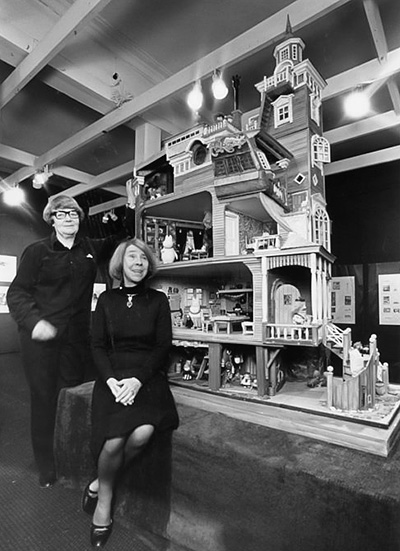
Имена Получение имени совсем не простая вещь в мире муми-троллей. Большинство героев называются по какому-то родовому признаку: имя либо сливается с ним, как, например, у Муми-тролля или Филифьонки, либо к нему добавляются уточнения, как у Фрекен Снорк или Снусмумрика. У множества героев имен нет, как нет их у Муми-мамы и Муми-папы. Снифф был безымянным зверьком всю первую книгу, а получает имя только во втором томе «Комета прилетает», но как он его получил, мы не знаем (зато знаем, что у него есть именины!). Рассказ о том, как назвать лодку, возможно, намекает на то, насколько сложные отношения с именами были у автора книги — ведь каждый видит в предмете что-то свое! Особенно таинственным кажется тот факт, что в 1930-е годы, когда Янссон пририсовывала страшненького муми-тролля (см. ниже) к своей подписи, она подписывала рисунок и «Снорк», и другими словами. В итоге между муми-троллями и снорками практически нет видовой разницы.
Кнютты Маленькие пугливые существа, которые прячутся, как только видят, что к ним кто-то приближается. Им посвящена детская книжка с картинками «Кто утешит малютку Кнютта».
Комиксы Почти сразу после выхода «Комета прилетает» Янссон начала рисовать комиксы о своих героях — первым был приключенческий «Муми-тролли и конец света». А в 1952 году, после того как первые книги о муми-троллях были переведены на английский, Янссон получила предложение о создании комиксов от британцев. В 1954 году она начала сотрудничать с Evening News и за пять лет написала 21 длинную комикс-историю о муми-троллях, сначала работая самостоятельно, а потом вместе с братом, художником Ларсом Янссоном. Герои комиксов еще свободнее выражают свои мысли, они кажутся более простыми и более грубоватыми, но обладают своим очарованием, а другой хронотоп и новый способ повествования создают еще одно измерение жизни муми-троллей.
Любовь Самое важное свойство муми-троллей — это умение любить себя и тех, с кем они оказываются рядом. Эта любовь пронизывает весь мир Туве Янссон, именно благодаря ей любой, даже самый измученный и несчастный герой, попавший в дом муми-троллей, становится немножко счастливее. Толерантность муми-троллей — это не политкорректность, не этикет, а любовное принятие другого как основа жизни. Муми-тролли не навязывают никому свои правила, а делают муми-дом родным каждому. Именно любовь и забота делают Дитя-невидимку снова видимой, именно на любви Муми-мамы и Муми-папы держится дом муми-троллей, а любовь между друзьями сплачивает их перед лицом любых опасностей.
Морра Главный антагонист муми-троллей и других жителей Муми-дален. Ее имя используется как ругательство. Морра замораживает все вокруг себя, ее все боятся, поэтому она невероятно одинока. В «Папе и море» Муми-папе удается помочь Морре согреться, и она даже танцует для него.
Муми-тролли Мягкие, похожие на бегемотиков обитатели Муми-дален — муми-тролли — самые добродушные существа в мире Туве Янссон. Их образы появились в рисунках Янссон еще во время работы в журнале Garm в качестве виньеток рядом с ее подписью и на политических карикатурах. В тот момент они фигурировали поодиночке и были не милыми зверьками, а худыми троллями с красными глазами, рогами и длинными носами. В первой книге о муми-троллях герои уже не так похожи на своих страшноватых предшественников, однако полноту и очарование они приобретают позднее — во второй и третьей книгах. Фантазия о муми-троллях — одна из самых ранних в жизни Янссон: ее дядя пугал троллями, которые дуют детям в затылки, а в своих дневниках она описывала их как пугающих и похожих на призраков сил из мира бессознательного. Таким образом, посреди ужасов войны Янссон обратилась к собственным детским страхам и постепенно приручила их, а затем по-настоящему полюбила.
Муми-тролль Существо, ставшее альтер эго Туве Янссон, сначала звалось Снорком или Нииску и было похоже на бесенка, а не на нежнейшее существо, к которому привыкли читатели за следующие десятилетия. Муми-тролль объединяет всех героев саги, а его путешествия и невзгоды — это еще и путь взросления. Муми-тролль добр, открыт настоящему и будущему и похож на обоих родителей, но отличается самостоятельностью и отсутствием тщеславия.
Первое известное изображение Муми-тролля — в виде граффити
Мумрики Загадочные и мудрые кочевые существа, которые как никто умеют наслаждаться каждой минутой жизни, не преследуя какой-то конкретной цели. Всю жизнь Туве Янссон сохраняла дружеские отношения с несостоявшимся мужем Атосом Виртайненом, который стал прототипом Снусмумрика; во многом именно благодаря его поддержке «Муми-тролли» увидели свет как книга, а не остались своеобразным хобби художницы Янссон. Папа Снусмумрика Юксаре появляется в «Мемуарах папы Муми-тролля» вместе с папой Сниффа, Шныриком. Мумрики не понимают материальных ценностей, любят старые шляпы и нуждаются в постоянной смене обстановки и личном пространстве, поэтому они не могут долго оставаться на одном месте, что печалит их друзей.
Мультфильмы В разных странах выходили и продолжают выходить мультфильмы о муми-троллях, как кукольные, так и рисованные. Можно вспомнить советскую экранизацию «Шляпы волшебника», а сейчас огромной популярностью пользуется японско-датский мультсериал и полнометражный мультфильм, заглавную песню к которому написала Бьорк. А вот сама Туве Янссон отношения к экранизациям никогда не имела.
Мюмлы Человекоподобное средоточие витальности: они любят веселиться, проказничать, ругаться и постоянно ищут приключений себе на голову. В отличие от сентиментальных и медлительных муми-троллей мюмлы быстры и сообразительны и никогда не жалеют себя. Слово Mymlan — сленговое словечко в кругу друзей Янссон, означавшее «любить». Еще одно альтер эго Янссон — Малышка Мю, острая на язык, знающая себе цену веселая проказница, которая говорит правду, а не то, что другие хотели бы услышать. Малышка Мю — настоящий трикстер, постоянно учиняющая беспорядок и вместе с тем необходимая для равновесия в муми-вселенной. Сама Янссон говорит о ней: «Мне нужен был кто-то, кого можно было бы противопоставить беззащитности и чувствительности семьи муми-троллей. Если ее убрать, останется сплошное нытье».
Нинни Нинни впервые появляется в книге «Дитя-невидимка». Она стала невидимой из-за отсутствия заботы и постоянного страха перед предыдущим опекуном. Опекун отдает Нинни Туу-тикки, а та приносит ее в Муми-дален. Сначала Нинни не понимает, как играть, и ведет себя довольно раздражающе, но постепенно она становится полностью видимой, а затем проявляет себя, и семья Муми-троллей понимает, что на самом деле она вообще-то похожа на Малышку Мю. Нинни меняется сильнее, чем большинство героев, потому что в Муми-доме впервые обретает себя.
Папа Муми-тролля Нежный, тонкий и находчивый, непризнанный гений Муми-папа — один из самых важных персонажей саги, недаром именно через призму его воспоминаний раскрывается предыстория других героев. Герой этот вобрал в себя черты скульптора Виктора Янссона, отца Туве, в той же степени, что Муми-мама списана с матери Янссон, шведской художницы-графика Сигне Хаммерштен-Янссон, которая в том числе разработала дизайн более 220 шведских почтовых марок. Но мама Муми-тролля — это поток любви, некий идеальный образ: у нее всегда есть средства, чтобы утешить сына и его друзей, она узнает Муми-тролля, даже когда он изменился до неузнаваемости, готовит самую вкусную еду и всегда берет с собой все необходимое (и гораздо больше). Муми-папа же гораздо сложнее и противоречивее: у него не самый простой характер, о чем он и сам хорошо знает: «Типичная черта моего характера — любой ценой производить впечатление на окружающих».
Писательское ремесло Помимо песенок, которые придумывает Снусмумрик, в тексте есть цитаты, воспроизводятся письма героев, и сама вещность этих писем важна — подчеркиваются особенности стиля (в угрожающем письме Привидения папа Снусмумрика видит, что автору нравится слово «судьба», а в поздравительном письме тетки Хемулихи важно отсутствие букв). Муми-папа объясняет, что такое клиффхэнгер: «Видишь ли, когда пишешь книгу, самое интересное в том, чтобы закончить главу именно тогда, когда всего страшнее». Отдельного упоминания стоит глава «О том, как пишут пьесу» из «Опасного лета». Мемуары Муми-папы делают его писателем (впервые он как будто невзначай так охарактеризован в конце последней главы), и семья уверена, что теперь он станет знаменитым. При этом в середину «Мемуаров» вложены слова, очевидно принадлежащие самой Туве Янссон, которая уже начинала уставать от сделавших ей имя персонажей: «Не думаю, что быть знаменитым приятно <…> Может, только в самом начале, а потом это кажется совершенно обычным; под конец же от этого становится просто худо: точь-в-точь как бывает, когда долго катаешься на карусели». Вскоре папу Сниффа как раз стошнит от катания на карусели, с которой он не может сойти, потому что боится, что больше не представится случай покататься.
Природа Муми-тролли и другие счастливые обитатели мира Туве Янссон находятся в единении с природой, они понимают ее законы и видят ее красоту. В отличие от них, хемули и филифьонки похожи на городских жителей, невротичных и не умеющих наслаждаться моментом. Описания природы Финляндии в перспективе малюсеньких созданий — горы и пещеры, море и лес, луга и деревья — выглядят волшебными для иностранных читателей, которым разноцветные мхи, северное сияние и постоянно наступающая вода интуитивно кажутся сказочным вымыслом.
Снифф Самый пугливый и трогательный друг Муми-тролля, появившийся еще в первой книге. Он часто бывает беспомощен, его постоянно тошнит от страха, ему вообще тяжело справляться со своими чувствами. Как и Фрекен Снорк, Снифф в какой-то момент пропадает из основного повествования, зато его домашней игрушке, песику Седрику, посвящена одноименная повесть, одна из последних в цикле.
Снорки Снорки очень похожи на муми-троллей, разве что они меняют цвет в зависимости от настроения и шерстка у них пушистее. Друг Муми-тролля Снорк — самый ответственный из «молодого поколения» мира Муми-дален, он обожает строить планы, решать проблемы и созывать собрания. «Снорк» по-шведски — нахал, но снорки не часто проявляют себя таким образом, эта характеристика лишь иногда шуточно обыгрывается в книгах. Фрекен Снорк — сестра Снорка и любовь Муми-тролля — деконструированная сказочная принцесса: Фрекен Снорк прекрасна, у нее самая красивая в мире челка, но она все время хочет стать больше похожей на даму: то она просит у волшебника сделать ей глаза, как у царственной красавицы с мачты корабля, то начинает стесняться, что ходит без платья. В какой-то момент героиня надолго пропадает из основного повествования.
Сюжеты Вплоть до «Волшебной зимы» книги о муми-троллях по сути своей приключенческие и связаны с противостоянием разным силам природы, но дальше наступает перелом, и сказки становятся психологическими, философскими в первую очередь, а число сюжетных перипетий заметно уменьшается. Книги «Папа и море» и «В конце ноября» с трудом можно назвать детскими, они больше похожи на философские притчи, в которых вместо людей или аллегорических фигур остались и получили новую глубину давно знакомые автору герои.
Смерть Часть мира муми-троллей, но напрямую о ней впервые говорится в «Волшебной зиме», когда герои решают, как им быть с замерзшим бельчонком: «Раз умер, так умер, — примирительно сказала Туутикки. — Этот бельчонок мало-помалу превратится в прах. А потом <…> из него вырастут деревья, и на них будут прыгать новые бельчата. Разве это так уж печально?»
Театр Тема театра крайне важна в мире муми-троллей, ведь именно в театре вместо дома оказываются герои в «Опасном лете», там же они пишут пьесу и разыгрывают представление, которое становится чем-то вроде психодрамы для Мисы. Сама Туве Янссон много работала в театре, а первая постановка «Муми-тролля и кометы» состоялась уже в 1949 году. В 1950-х годах Янссон создавала детские пьесы о муми-троллях с Вивикой Бандлер, ее подругой и любовницей — прототипом Вифслы. А в 1974 году состоялась премьера «Муми-оперы» на музыку финского композитора Иллка Куусисто.
Тофсла и Вифсла Два маленьких существа, появляющиеся в «Шляпе волшебника», — это Туве и Вивика Бандлер в период их влюбленности. Они во многом похожи на мюмл, веселы и общительны, у них смешные носы трубочкой и свой собственный язык. Это они умудрились украсть у Морры королевский рубин, который искал по всему миру Волшебник из «Шляпы волшебника».
Туу-тикки Жизнерадостная, находчивая и умная обитательница купальни Муми-папы из «Волшебной зимы» открывает Муми-троллю новый мир с его радостями и опасностями. Именно так Туве Янссон открыла новые возможности «Муми-троллей» благодаря ставшей любовью всей ее жизни художнице Тууликки Пиеттиля (она — прототип Туу-тикки, что легко распознать благодаря внешнему сходству). Сама Туве Янссон говорила, что зимний холод и окоченение — это то, что она чувствовала, когда устала от своих персонажей и их приключений и мечтала закончить сагу, которая принесла ей деньги и признание. В книге холод сковывает все чувства маленького Муми-Тролля, и тот грустит, но потом встречает мудрую и добрую Туу-тикки, которая показывает ему, как прекрасна может быть зима. В жизни произошло то же самое. «Волшебная зима» — это книга о том, как Туве встретила Тууликки, и после этой встречи они не расставались более 50 лет, до самой смерти Янссон.
Туве Янссон и Тууликки Пиетиля
Филифьонка Нежное и грустное, похожее на крысу существо из рода филифьонок, которое никак не может разрешить себе быть счастливой. У Филифьонки много переживаний и тревог, она постоянно боится свободы и будущего, почему и оказывается в состоянии «ожидания катастрофы». Однако в книге «В конце ноября» Филифьонке удается избавиться от своих страхов и последовать своим желаниям — приехать в любимый Муми-дол.
Хаттифнатты Немые и глухие жители мира муми-троллей, у которых однако обострены другие чувства. Они живут и передвигаются большими группами, а при прикосновении жгутся — этим, а также одновременно отталкивающим и завораживающим видом напоминая медуз. Гроза заряжает их электричеством. Своеобразная противоположность хаттифнаттов — клипдассы: общительные животные, отдаленно напоминающие тюленей, ненавидящие одиночество, живущие колониями и любящие все грызть.
Хемули Олицетворение скучного (хотя порой необходимого) взрослого порядка вещей. Хемули любят заниматься чем-то одним и не интересуются ничем, кроме собственного важного дела, они серьезны, временами суровы и редко счастливы. Хемули и хемулихи, вне зависимости от профессии, постоянно что-то запрещают или стараются ограничить свободу других. С ними тяжело, хотя ничего специально злого они не делают. Преисполненный страданий и ненависти к себе хемуль из «В конце ноября» — один из самых трагических персонажей мировой литературы, не только сказок.
Хомса и Миса Несчастные двойники Тофслы и Вифслы, которые любят друг друга, но не умеют утешить. Миса постоянно плачет и чувствует себя обиженной либо виноватой, она очень мнительна, и ей трудно жить — настолько же, насколько легко малышке Мю. Именно у Мю и у дочери Мюмлы Миса и научается просить о том, чего хочется. Для самой Янссон Миса — очень важная героиня: «Если мои истории и адресованы какому-то конкретному типу читателей, то это, наверное, Мисе. Я имею в виду тех, кому тяжело быть как все, тем, кто всегда остается поодаль, с краю, не в своей тарелке…». Хомсы — еще один род существ, к которым относится, например, Тофт из «В конце ноября».
Шведский язык Туве Янссон — дочь шведскоговорящего финна и шведки, которая всю жизнь писала на шведском языке, поэтому и имена героев «Муми-троллей» соотносятся именно со шведским.
Эмоции Задолго до того, как «эмоциональное воспитание» стало важной частью педагогики, и методисты и писатели задумались о том, как помочь детям понимать свои эмоции и справляться с ними, Туве Янссон создала целый эмоциональный словарь исключительно для себя. Сейчас карточки эмоций муми-троллей — отличная детская игра, которую на Западе можно купить в магазине. Мало в какой книге так много внимания уделяется оттенкам чувств, например: «Мама в ужасно дурном настроении» — «Она сердита или расстроена?» — «Скорее расстроена». А волшебник в конце «Шляпы волшебника» делает так, что печаль покидает Муми-тролля, а тоска превращается в ожидание встречи. Ну а с высотами психологизма «В конце ноября» и «Папы и море» сравнится мало какая взрослая литература.
Янссон, Туве Создательница вселенной муми-троллей Туве Янссон (9 августа 1914 — 27 июня 2001) была художницей, писательницей и карикатуристом. Ее «взрослые книги» значительно менее известны, чем сказки, хотя тоже переведены на многие языки, а «Летняя книга» является классикой финской литературы. При этом главным своим призванием Янссон считала живопись, которой занималась многие годы, вплоть до конца 1970-х годов. Но и в живописи сюжет был для нее крайне важен. Свою первую книгу с иллюстрациями «Сара и Пелле, и осьминоги Водяного» она написала в 14 лет. О своей личной жизни в интервью Янссон не распространялась и журналистов избегала, при этом не скрывала свою бисексуальность даже в 1950-е годы, когда гомосексуальность в Финляндии была уголовно наказуема, не делала тайны из своих любовных связей и охотно беседовала с исследователями, занимавшимися правами ЛГБТ-сообщества и изучавшими творчество Янссон с гендерной точки зрения. Осталось множество кинопленок, запечатлевших жизнь Туве Янссон и Туулике Пиетиля на острове недалеко от Хельсинки, куда они приезжали на лето. В 1966 году за свой «многолетний вклад в детскую литературу» Янссон получила самую престижную детскую литературную награду имени Ганса Христиана Андерсена.
Туве Янссон плавает рядом со своим домом


